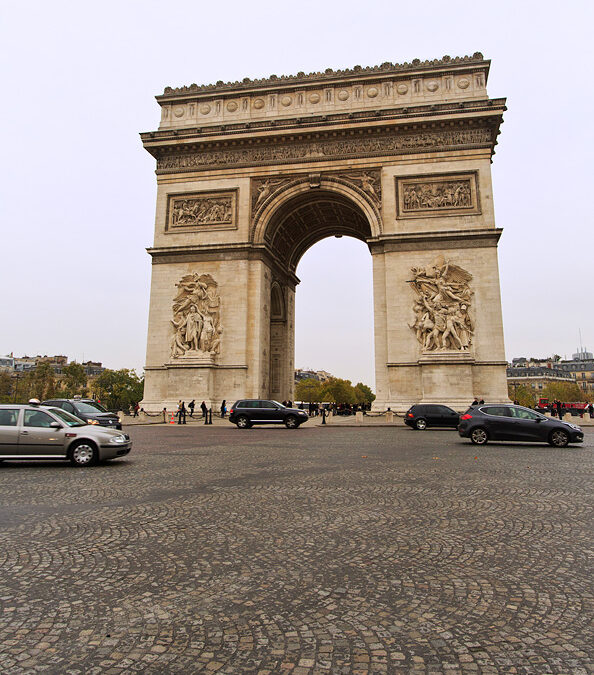
by Scott Martin Photography | Dec 21, 2013 | Blog, Cityscapes, Landscapes, Travel
After leaving Geneva we headed northwest for the 550km trek to the great city of Paris, where we stayed for three days at the Hotel Pullman Paris Tour Eiffel close to the base of the iconic tower which will be the focus of the next post.
Paris is the largest city in France with a population of more than two million and a metropolitan area of over twelve million people. It is located on the River Seine where it was first settled over two thousand years ago.
The Avenue des Champs Elysées is probably the most famous street in Paris, stretching almost two kilometres between the Arc de Triomphe to the west and Obelisk de Luxor to the east. It is home to some of the most expensive real estate, high end fashion boutiques and jewelry stores in the world.
Place Charles de Gaulle is a large area that serves as the origin of twelve straight roads including the Champs Elysées that spread out like giant spokes in a wheel. In the centre of the place is the Arc de Triomphe. This makes the Arc de Triomphe the centre of one of the busiest and scariest roundabouts in the world. It is said that there are eleven lanes of traffic circling around the Arc with absolutely no lane markings on the cobblestones that make up the roadway. It was fascinating to observe and I’m very happy we left our rental car at the hotel and walked.
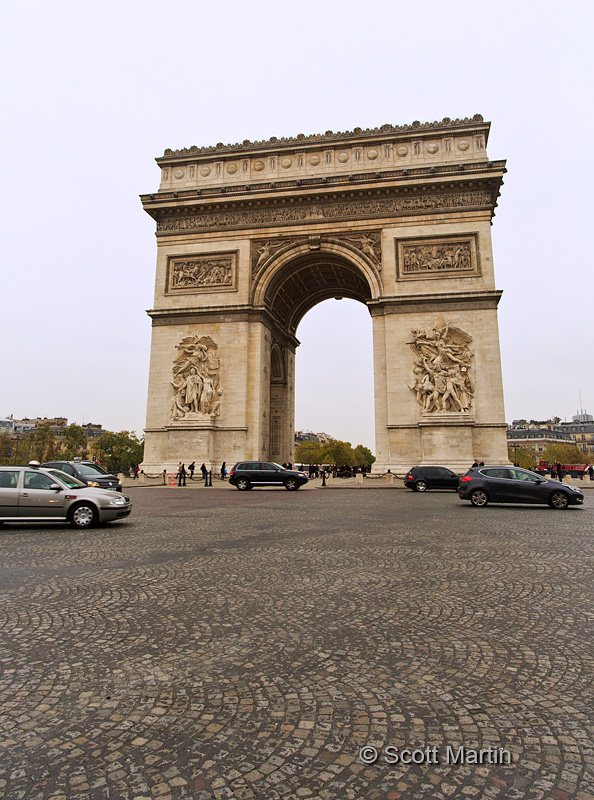
The Arc was commissioned in 1806 but not completed until about thirty years later. It was patterned after the Arch of Titus in Rome and was built to remember the French soldiers who fought & died in the French Revolutionary and Napoleonic wars. Below the arc is the Tomb of the Unknown Soldier remembering those who perished in the First Great War.
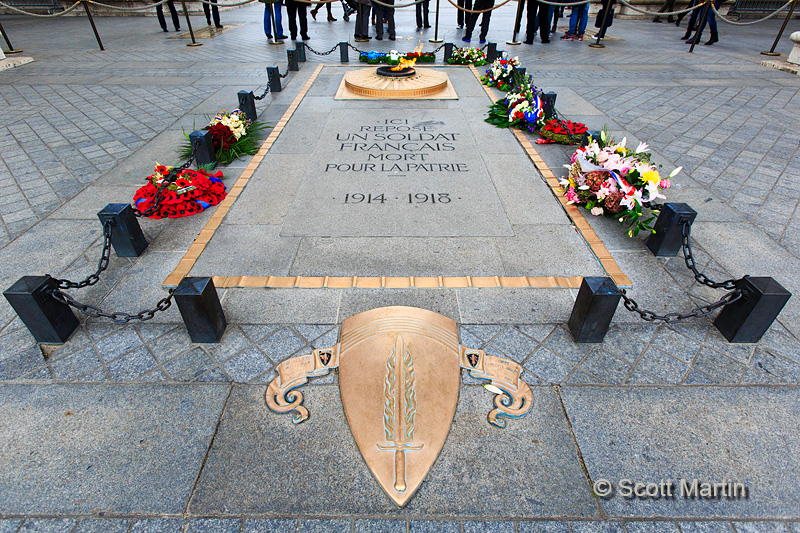
The names of those remembered are carved on the walls of the Arc, while the arches are intricate marble tiles which makes for an interesting wide angle shot looking up from the centre of the Arc.
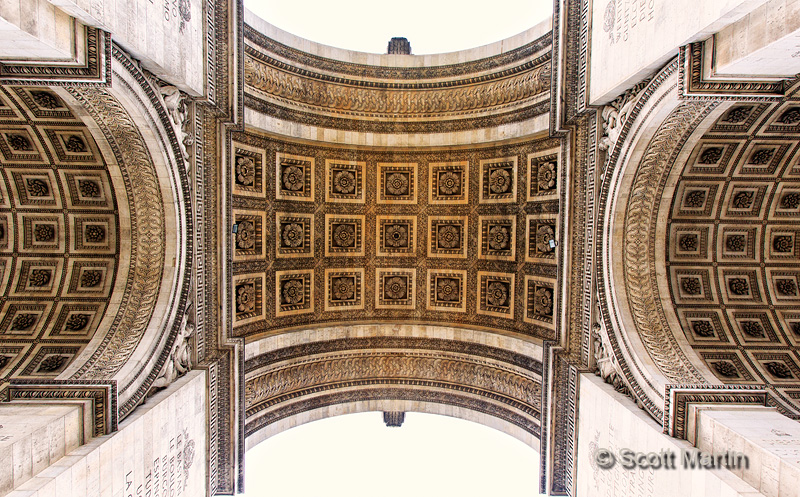
The Arc de Triomphe was fun to photograph at night as the hundreds of cars that are racing around its base provide some interesting lighting effects.
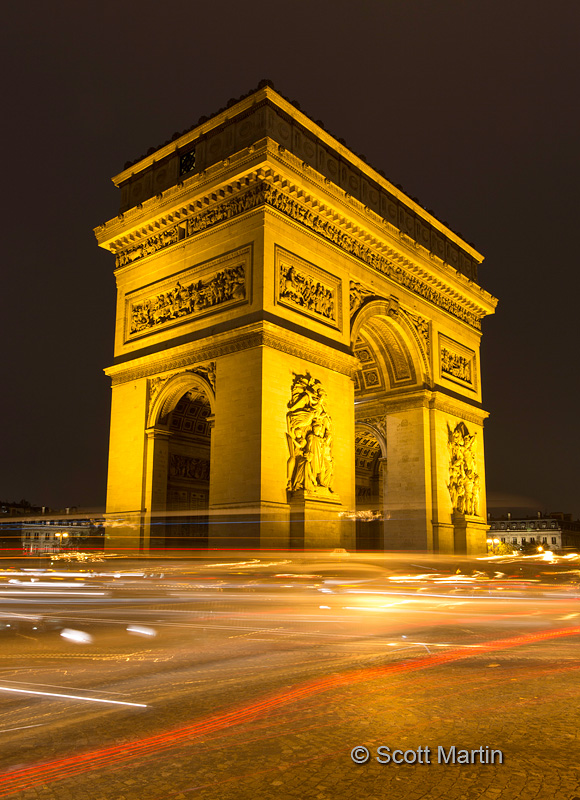
I didn’t notice the dog in the back of the car while taking this next shot, however it has become one of my favourite elements of the image.
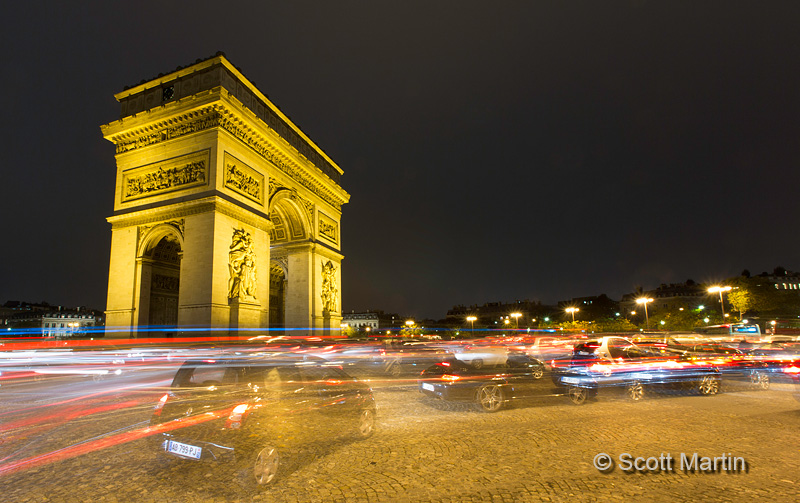
These last two images of the Arc are more classic views, however also required placing oneself into the middle of the traffic to get the desired composition. The first image was taken with a 70-200mm lens from the middle of the Champs Elysées about three blocks from the Arc in order to frame the Arc with the trees and streetlights. It was taken at f/22 to create the starburst effect on the streetlights.
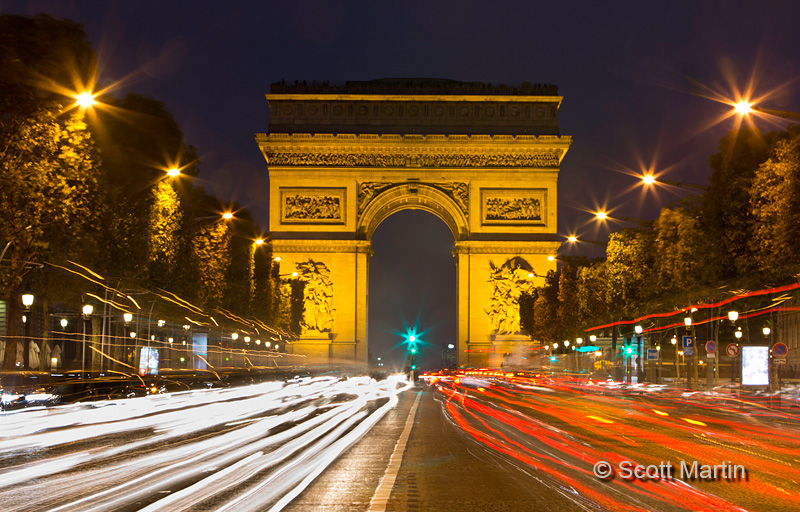
The last shot is similar to the one above however taken on a different street from a vantage point much closer to the Arc using a 16-35mm lens to provide a feel for the curved motion of the vehicles entering and exiting the roundabout.
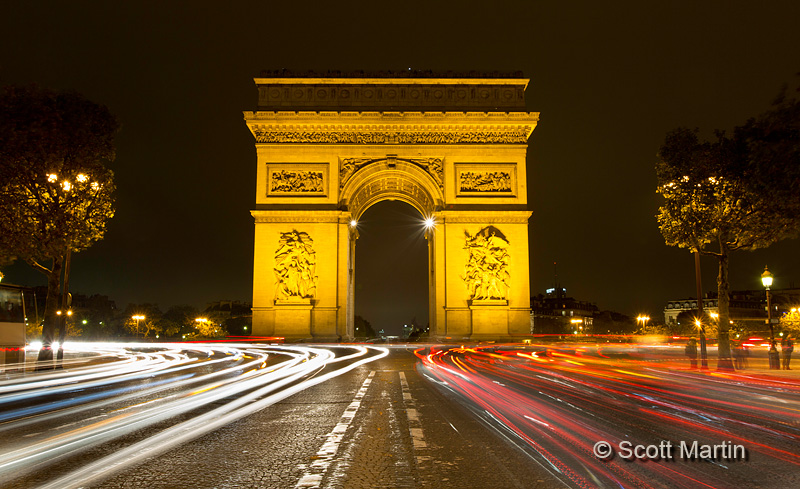
We walked the three miles between the Arc and the Louvre down the Champs Elysées and the following are a few snapshots along the way.
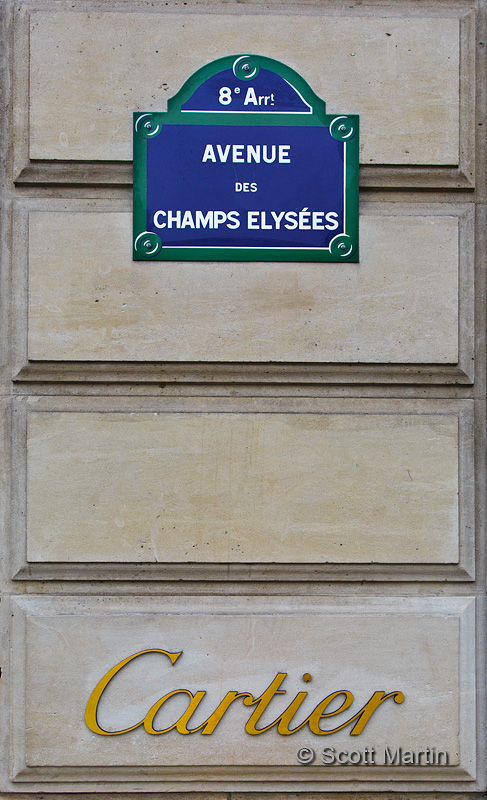
We didn’t buy any jewelry at Cartier, however we did stop at my new favourite shop, LaDuree, the worlds best (and probably most expensive) bakery.
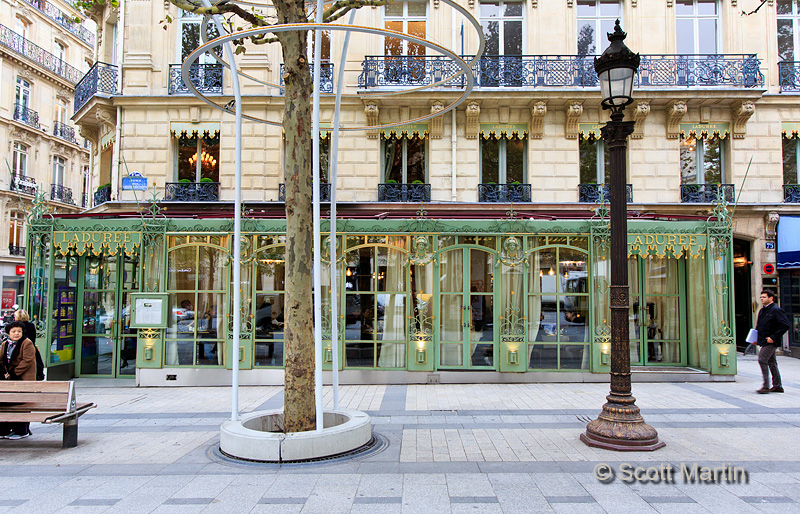
Absolutely spectacular!
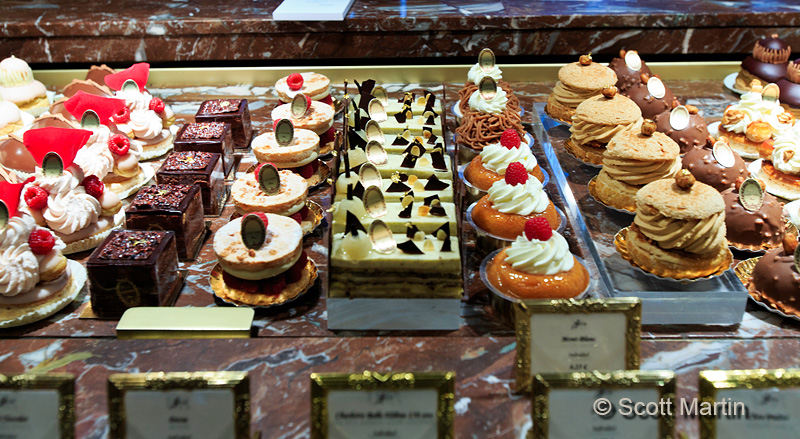
When you think of Louis Vuitton in Canada, you picture a small high end boutique…..in Paris its a department store!
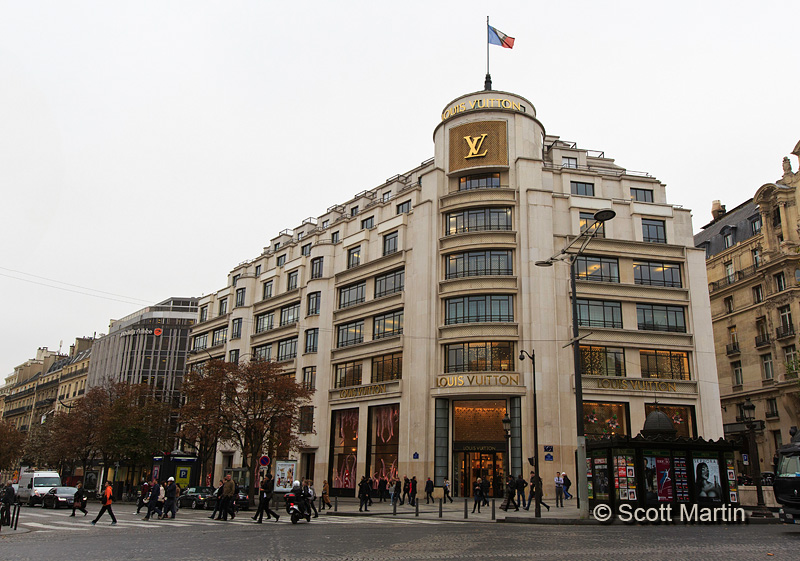
The Champs Elysées ends at the Obelisk of Luxor which stands in the middle of the Place de la Concorde. It first stood in front of the Luxor Temple in Egypt over 3,300 years ago. The 75′ high yellow granite obelisk arrived in Paris on December 21, 1833, exactly 180 years ago today!
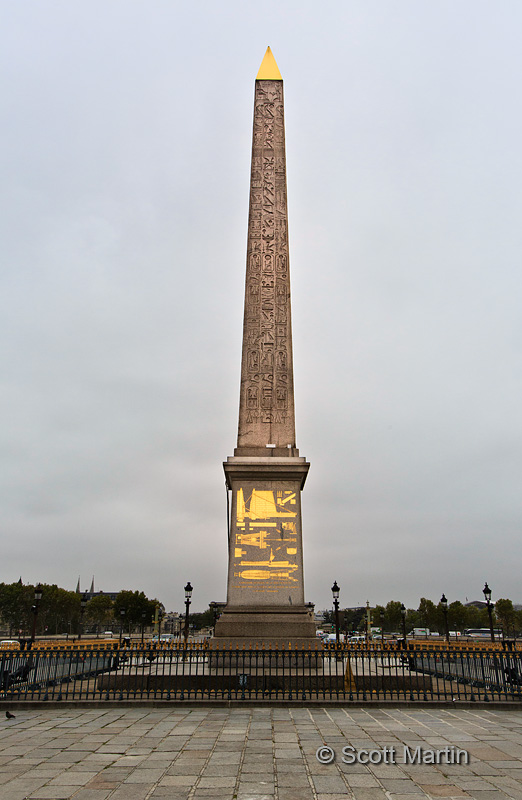
Beyond the obelisk to the east are a number of parks and museums stretching out about a kilometer before arriving at the Louvre.
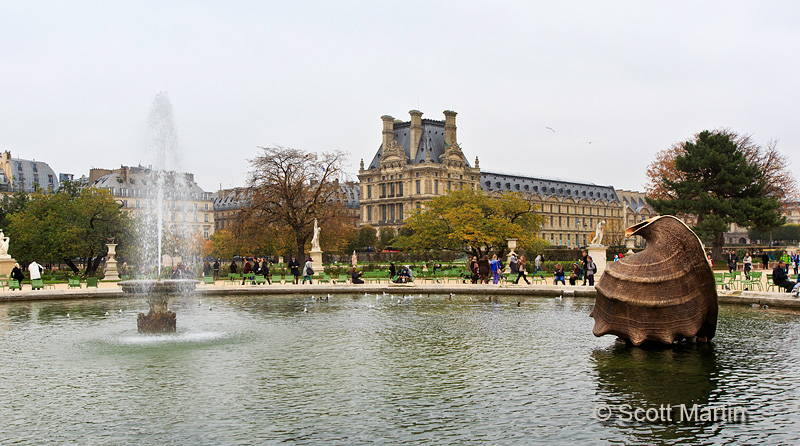
The last park you pass through on the way to the Louvre is Place du Carrousel in the centre of which is the Arc de Triomphe du Carrousel which stands in perfect alignment with the Obelisk Luxor, the Champs Elysées and the Arc de Triomphe in Place du Gaulle almost three miles away. The Carrousel Arc is older and about half the size of the Arc de Triomphe.
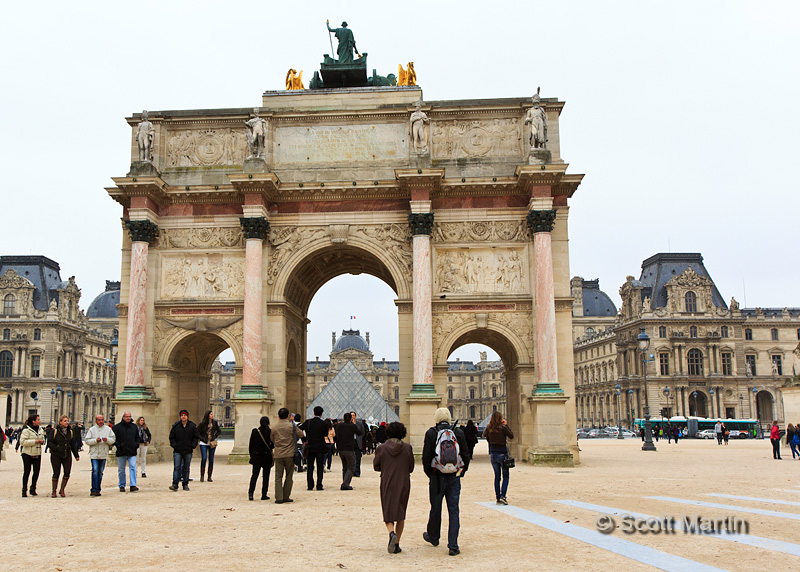
…..and the typical tourist shot 🙂
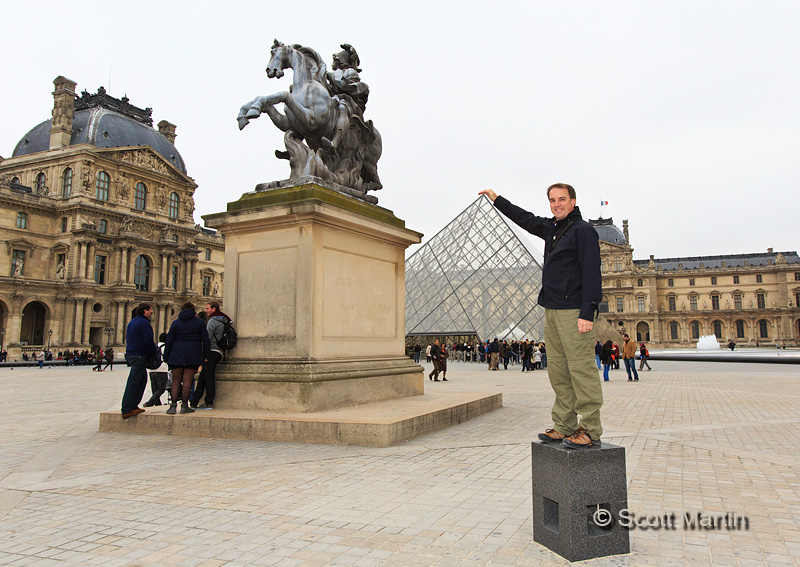
One of the things that surprised me about the Louvre was its sheer size as well as how the modern glass pyramids rise out of the central square yet don’t seem to detract from the old architecture of the museum buildings themselves.
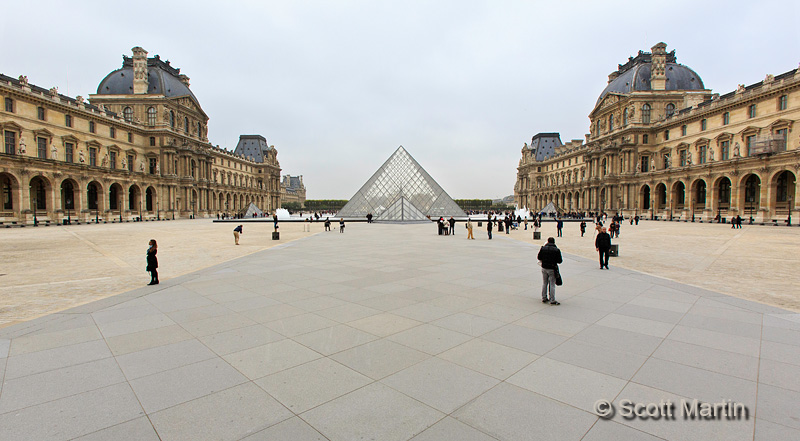
.
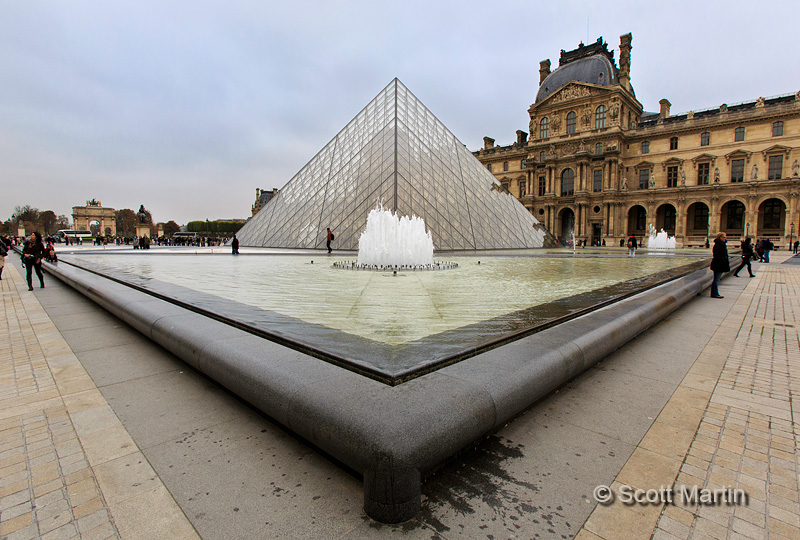
.
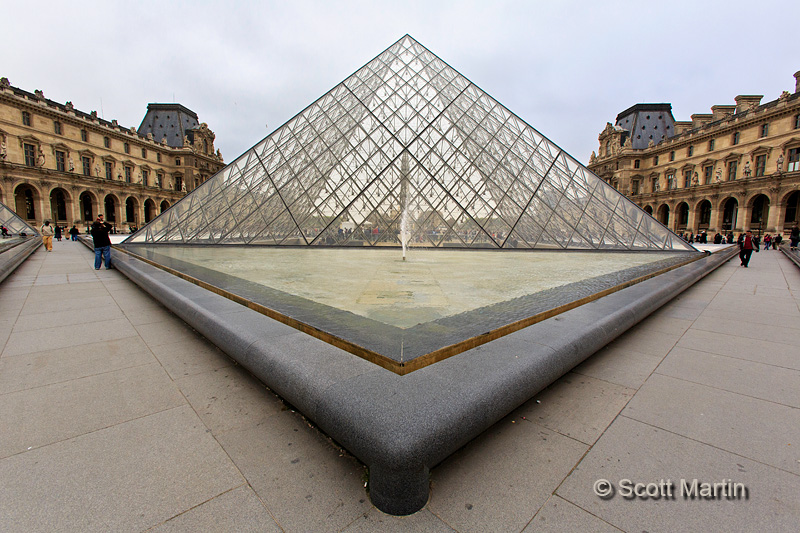
.
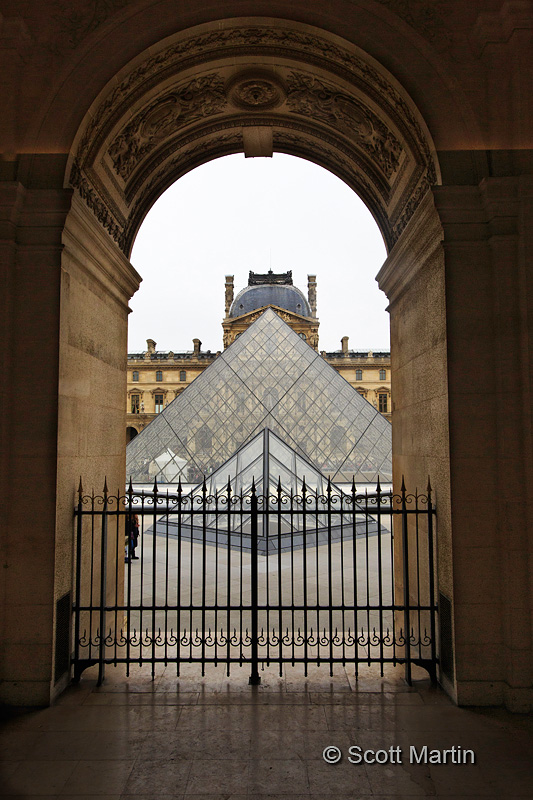
.
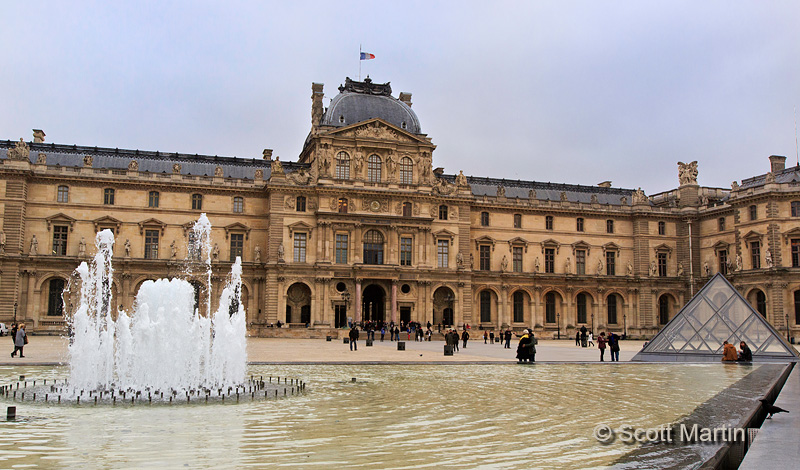
Using my iPhone, I recorded a 360° panorama using an app called Photosynth. Click here to check it out. (Note: The pano works fine on Chrome and Firefox however I did have problems viewing it on Safari)
The main entrance to the Louvre is through the central pyramid and down into a cavernous subterranean lobby accessed by a large circular stairway.
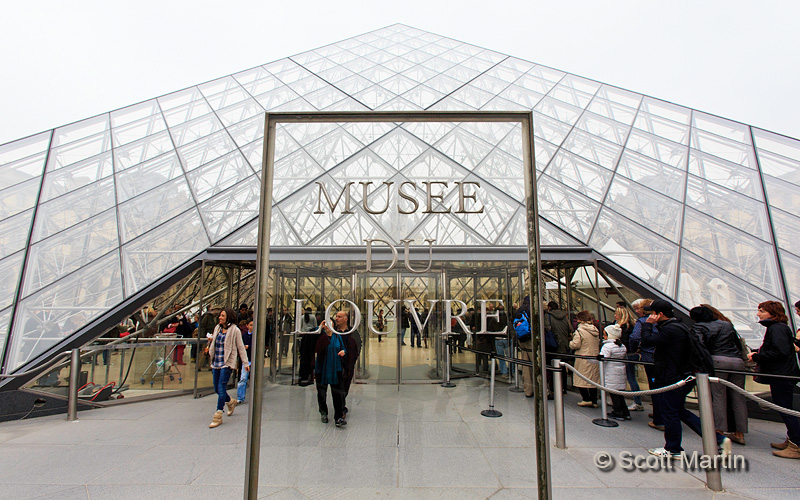
.
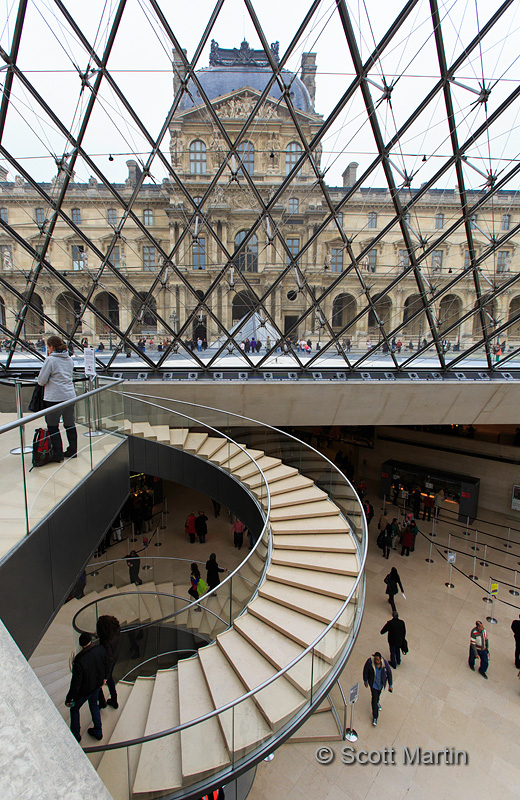
The next image is interesting for the photography enthusiast. It is an in-camera ±3 stop HDR that is processed in the 5D MkIII and saved as a single image. You can customize the exposure settings as well as how the images are processed. Once set up, the camera takes three different exposures of the same scene and then merges them into one image which it saves before deleting the three original images. HDR is an acronym for High Dynamic Range , which refers to scenes where the light intensity within the frame exceeds the ability of the camera to correctly expose the image with one shot. In the image below I metered on the central yellow pillar and set the camera to take one shot at that exposure plus one three stops over-exposed (to properly record the dark areas in the lobby) and one three stops under-exposed (to properly record the bright sky). Putting those three shots together resulted in the shot below. The amazing thing was that all of this happened with one trip of the shutter. Photographers have been doing HDR shots for years, however they always took lots of time ‘developing’ them on the computer afterwards.
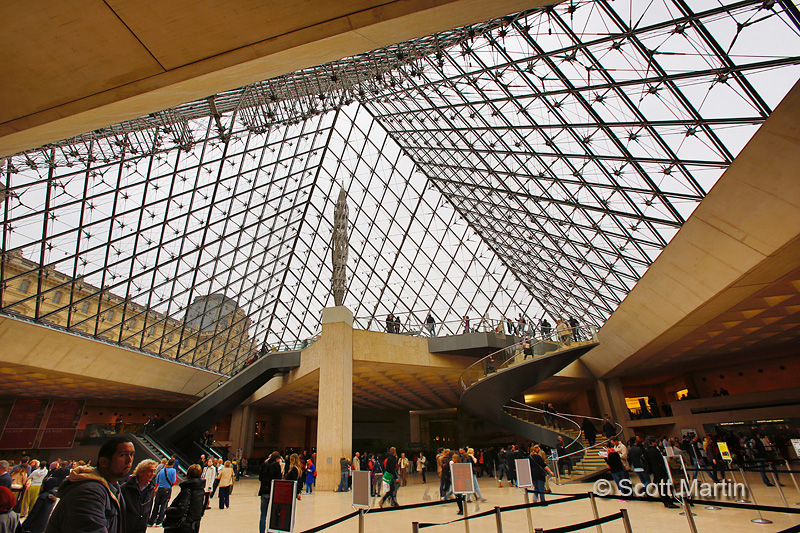
Wandering through the seemingly endless maze of hallways and galleries within the Louvre was fascinating for Deb & me, even though neither one of us grew up with an appreciation for the arts. I could include many images however will pare them down to arguably the two most famous pieces found within the walls of the Louvre. The Mona Lisa and Venus de Milo.
The Mona Lisa was painted on a white poplar panel around 1506 by the Italian painter Leonardo da Vinci. Although not small, the 30×21″ painting is not as large as one expects when viewing it for the first time.
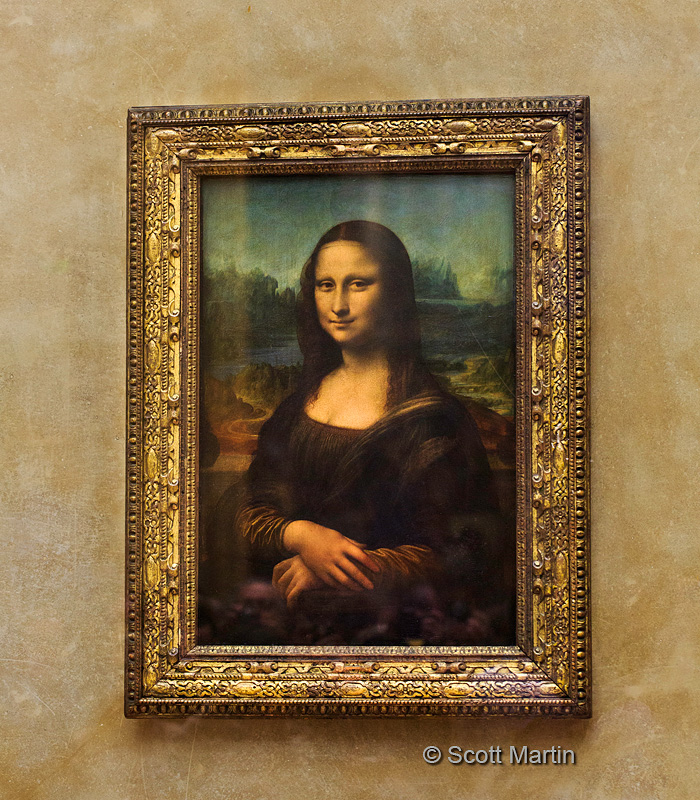
Venus de Milo, or more correctly Aphrodite of Milos, is a 6’8″ white marble statue carved sometime between 130-100 BC by Alexandros of Antioch. Its larger than life size and folk-lore suggest that it depicts Aphrodite, the Greek goddess of love & beauty, known to the Romans as Venus.
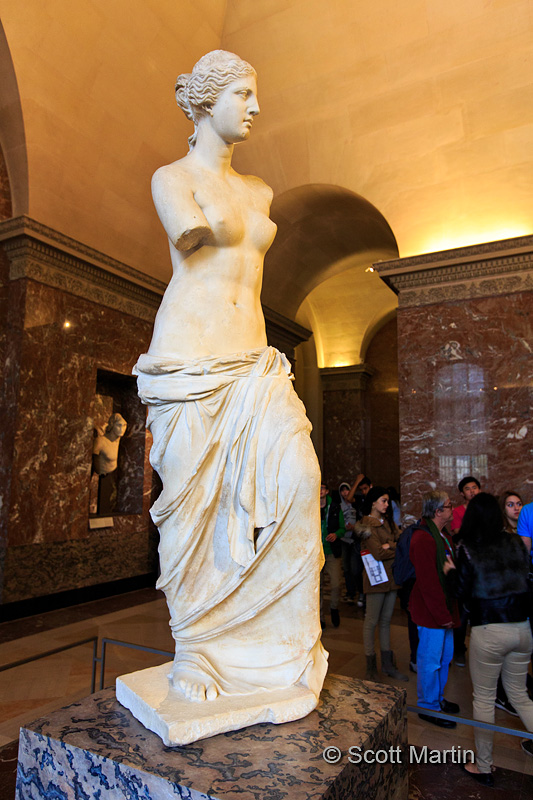
After finishing our tour of the Louvre we crossed over to the left bank of the River Seine and headed towards Notre Dame and the Eiffel Tower which will be the subject of the next blog post.
A very Merry Christmas to all who stop by the blog and I look forward to keeping in touch with you in 2014.
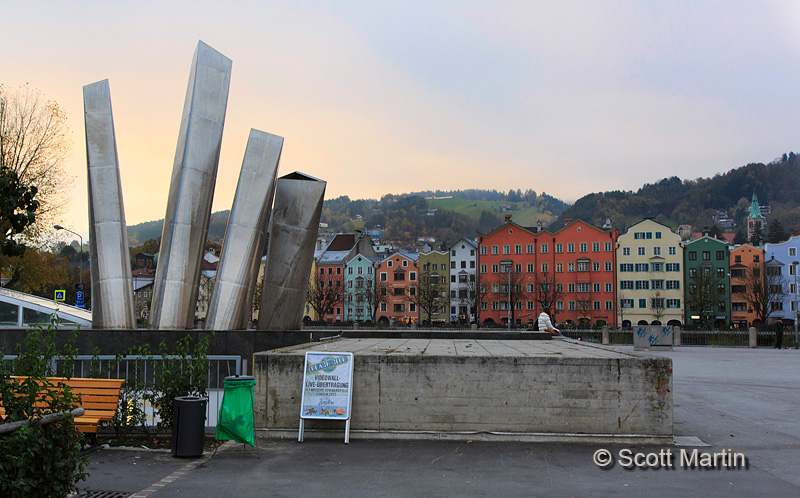
by Scott Martin Photography | Nov 23, 2013 | Blog, Cityscapes, Educational, Landscapes, Travel
After one last Vaporetto ride along the Grand Canal, we arrived back at the Venice Car Park where we loaded up our luggage and headed North for the 400 km drive to Innsbruck, Austria. The sun was descending below the mountains when we arrived at our hotel in the Old Town section of Innsbruck. We walked to the Town Square where we enjoyed some fine Austrian cuisine after which we wandered around recording some memories of this city that hosted the 1964 and 1976 Winter Olympics.
The remnants of the Olympic flame monument in the park where the Olympic medals were awarded almost fifty years ago.

The Goldenes Dachl, or Golden Roof is Innsbruck’s most famous landmark and is a three-story balcony built in the fifteenth century as a palace for Emperor Maximilian I. The balcony was their private perch for watching the festivals that took place in the town square below. The golden roof is made from 2,738 gold-plated copper tiles and they really do serve as the focal point of the square.
The Goldenes Dachl at dusk.
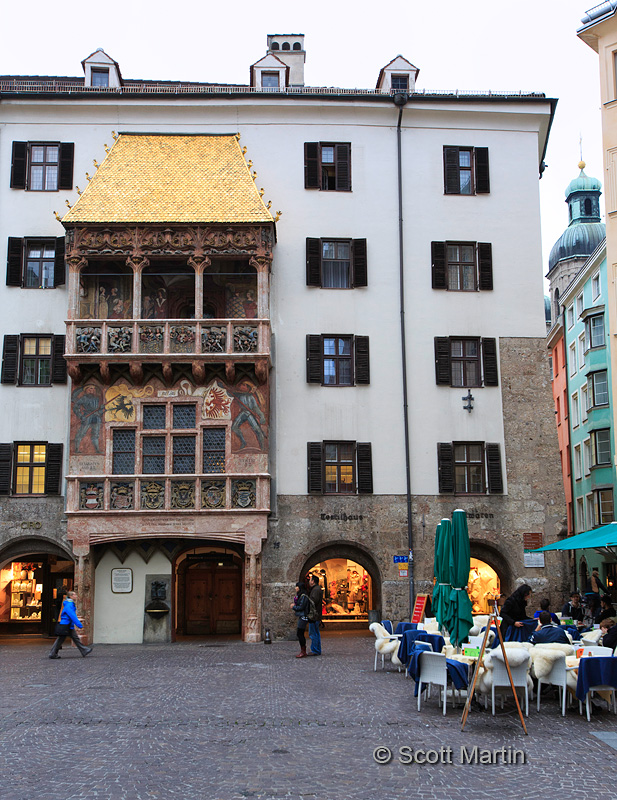
…and after dark.
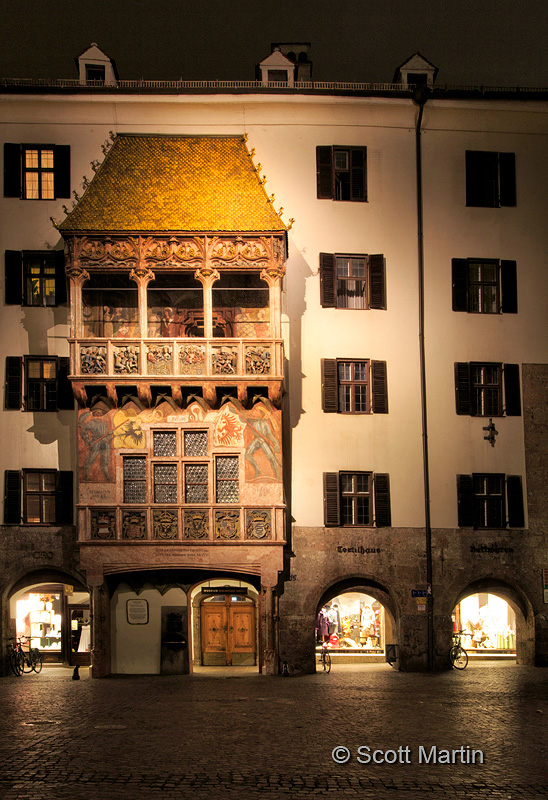
The town square in Old Town is a wonderful area that has remained relatively unchanged for the last 500 years. There are many cafe’s around the perimeter of the square that are designed for warmth in the colder weather, right down to the sheep skin throw blankets on every chair.
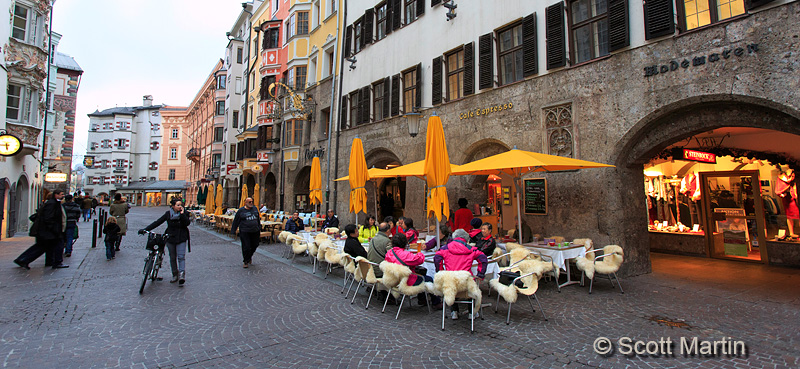
The Innsbruck Cathedral or Cathedral of St. James, a Baroque Cathedral built between 1717-1724.
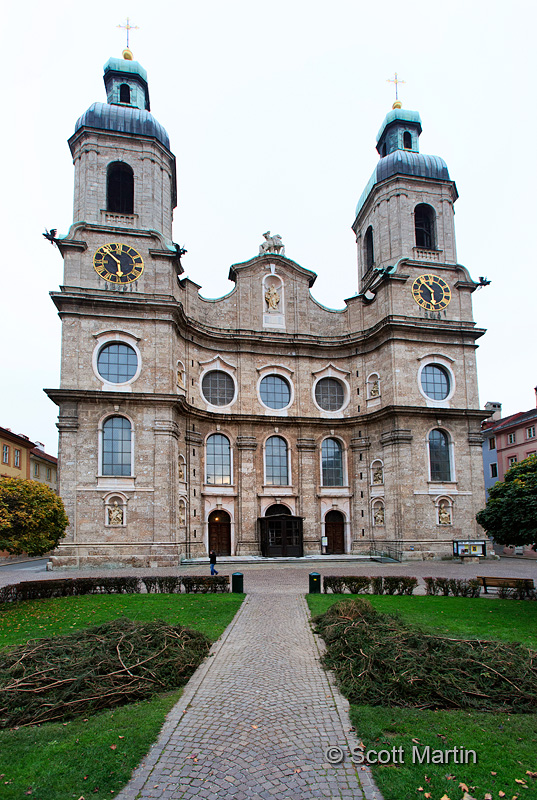
Helblinghaus dates back to the fifteenth century and was constructed as a town house. The ornate detail of the facade is in keeping with its neighbour with the golden roof!
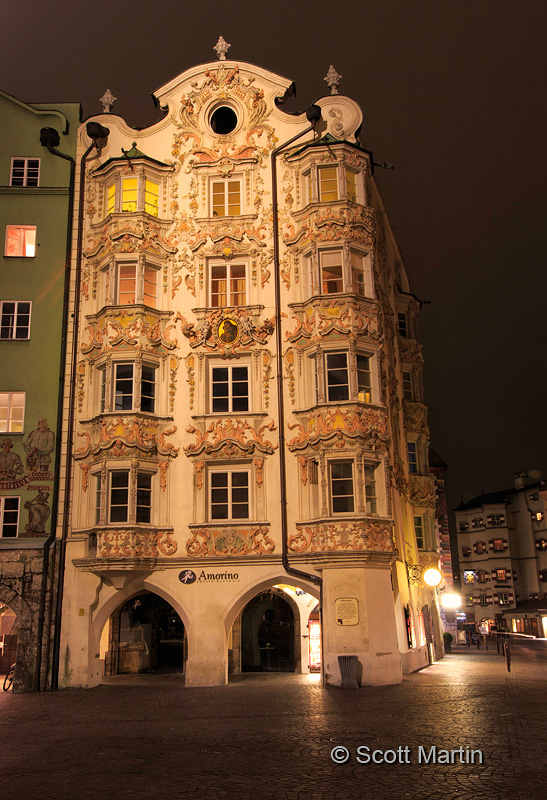
This last image from Innsbruck is the City Tower, another focal point of the Old Town district of Innsbruck.
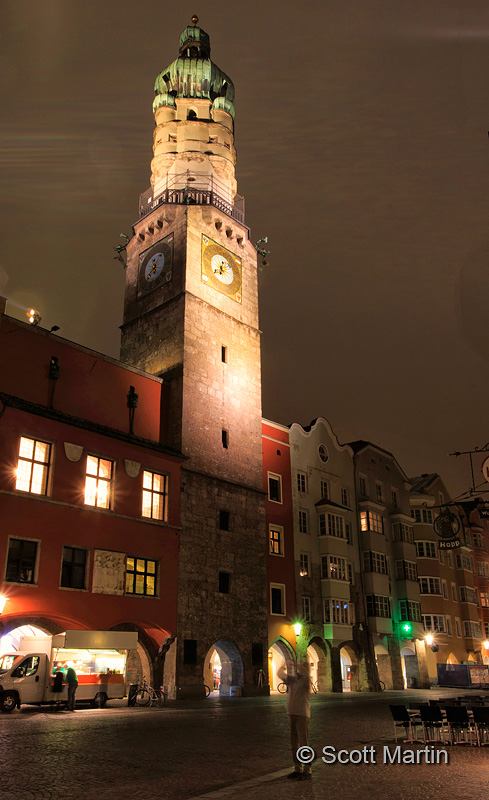
Following our very brief one night stay in Innsbruck we headed west, through Austria and Switzerland to our next stop which was Geneva, nestled on the edge of Lake Geneva on the Swiss/French border, some 580 km from Innsbruck. This day was designed for us to enjoy driving through the Alps and seeing one of the most picturesque mountain ranges in the world. We did enjoy the day however did not see a single mountain thanks to a very low cloud ceiling that day that extended the entire distance between Innsbruck and Geneva. Hopefully we will fare better the next time we make the trek!
Geneva is a fabulous city and it would have been nice to spend more time there, however we arrived late in the day and were on the road early the next morning heading towards Paris. The metropolitan Geneva area has a population of over one million people and has the third highest quality of life of any city in the world (after Vienna and Zürich). It boasts more international organization headquarters than any other city in the world and not surprisingly is rated as the third most expensive place in the world in which to live. We instinctively knew this because the burgers and fries at the restaurant where we had diner were thirty eight Euros!
For our evening in Geneva we headed down town to the old centre of Geneva where the University of Geneva is located. Adjacent to the university are some of the city’s cultural landmarks. Below is the Geneva Theatre.
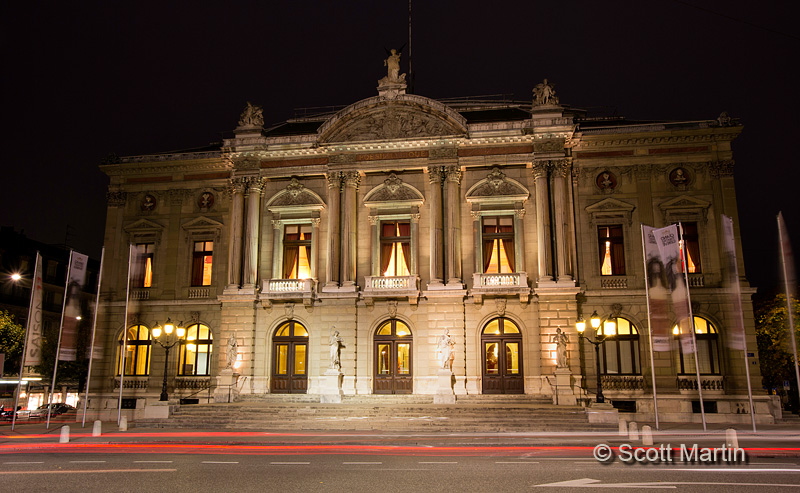
And a little different perspective. Unfortunately it was impossible to include the fountain and not the light standard.
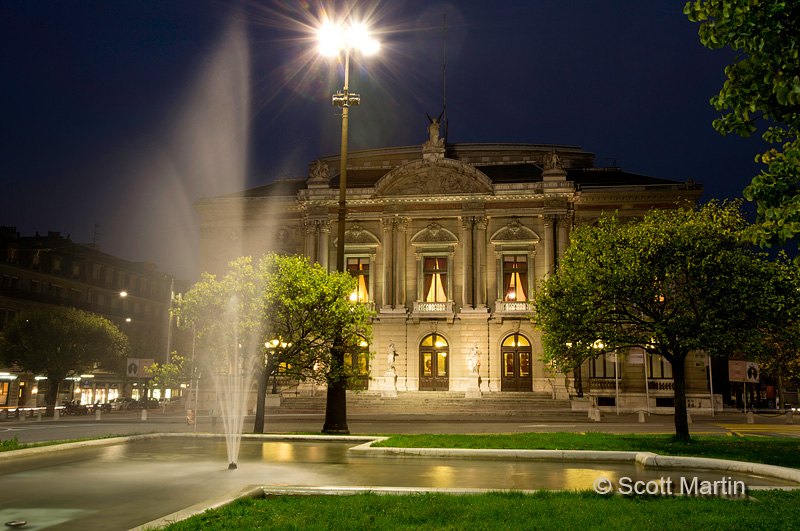
Next to the theatre was the museum , again with an annoying light standard. If you look closely you will note the streetlight is behind the statue of the horse & rider, which would typically result in the statue being underexposed as it was completely back lit. To solve this problem, during the thirty second exposure I grabbed the flash and ran up to the statue base and fired the flash at the horse & rider about six times while I made sure to never stop moving (so I didn’t show up in the picture). This technique is know as light painting and is a common practice in night photography. It takes a bit of practice but is not really that difficult….just don’t stop moving!
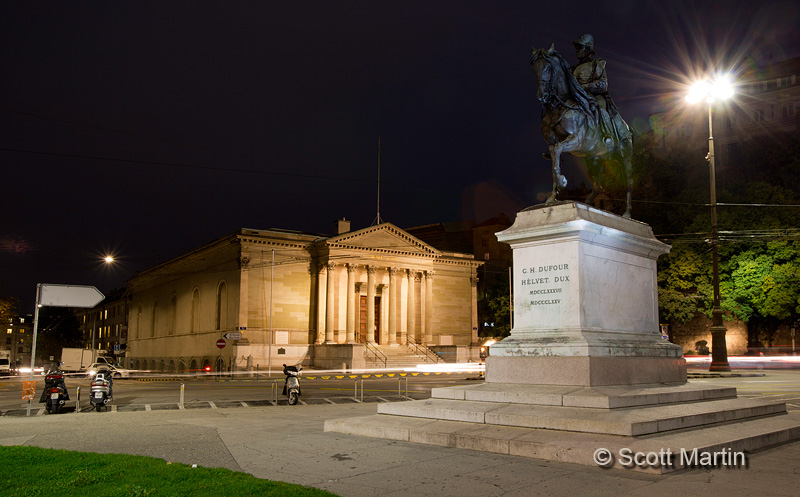
The University of Geneva is a sprawling campus in the heart of the old city. On its park like setting there are many academic buildings, lecture halls, dormitories and libraries however my favourite was this little cafe with bigger than life checker and chess boards out front for anyone to play.
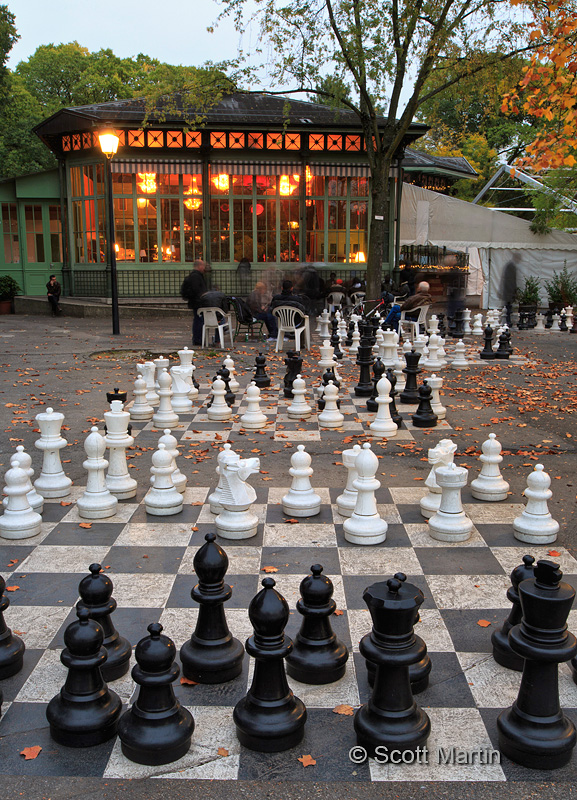
The reason we visited the university was to see Reformation Wall which is a 100 metre long monument built into the side of the old wall of the city of Geneva. Reformers Wall was constructed in 1909 to commemorate the 350th anniversary of the founding of the University of Geneva by John Calvin on June 5, 1559. The wall features ten prominent theologians of the Reformation period in the mid fourteenth century. Although John Calvin is noted as the founder of the university, he is best know for his role in the Protestant Reformation initiated by Martin Luther who nailed his Ninety Five Theses on the door of his church on October 31, 1517, a document that ‘protested’ (hense Protestant) the theology, doctrine and structure of the Roman Catholic Church. In 1536 John Calvin published his opus “Institutes of the Christian Religion”.
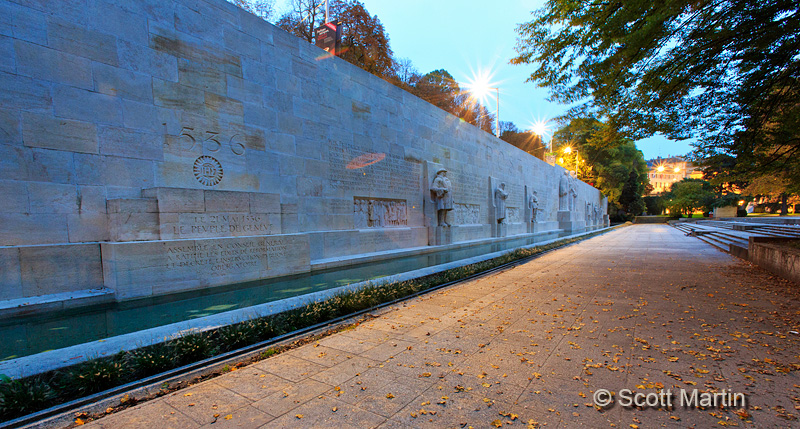
In the centre of Reformation Wall are statues of (from left to right) William Farel, John Calvin, Theodore Beza and John Knox that stand 16.5′ high.
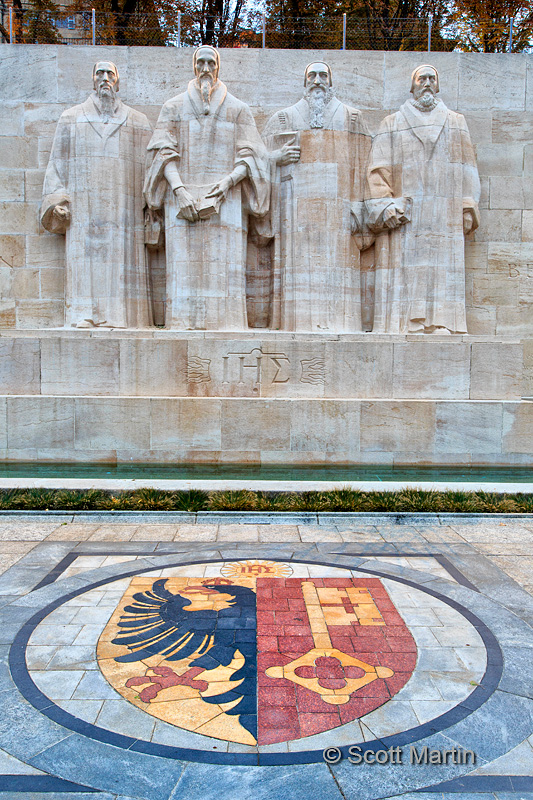
Although the above image may look like it was taken on a dull day, it was really taken in the virtual dark and is a 25 second time exposure.
I trust you have enjoyed these few images from Innsbruck and Geneva. It was unfortunate that we couldn’t spend more time exploring these two cities but it is impossible to fit everything into one trip! After one night in Geneva we headed to Paris where we spent almost three days and took enough photographs to supply the material for more than one blog post.
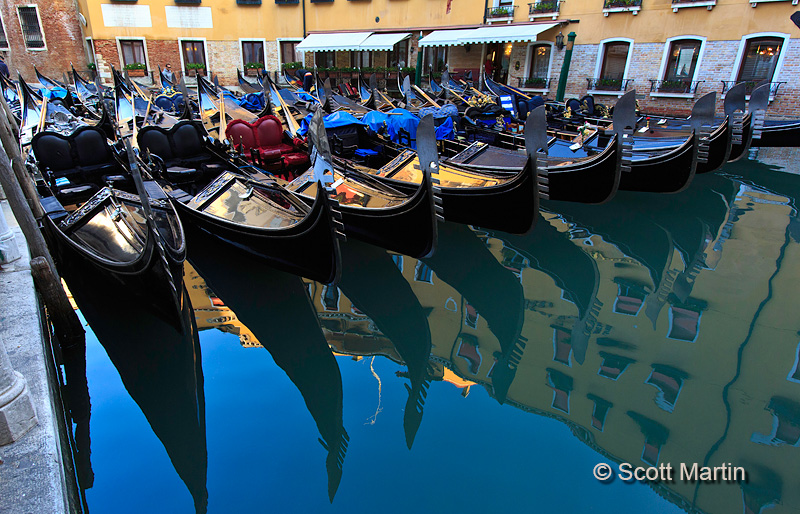
by Scott Martin Photography | Nov 16, 2013 | Blog, Cityscapes, Landscapes, Travel
This last blog post from Venice will highlight some of the more artistic, iconic views of the city that I trust will show the wide-ranging photo opportunities that exist in The City of Light. Venice has many nick names and the one I’ve chosen today serves to highlight the fact that lighting is the most important factor that must be considered when talking any picture. Being at the right place with bad light means you are there at the wrong time. Deb and I spent our first half day in Venice with a professional photographer, Marco Secchi, and our time with him was invaluable. Marco showed us the sights of Venice, had us at the right places at the right time when the light was perfect and helped us plan the rest of our time in Venice allowing us to find the best places to fully experience the city in the almost three days we spent there. Most of the images in today’s post were taken while we were with Marco. If you ever plan to be in Venice, you need to arrange your travel plans around Marco’s schedule!
Some of the 450 gondolas that ply the canals.

These next two images illustrate how two very similar pictures can create different results based on a slight change in composition. I probably took a dozen or more shots of this scene, and am still not sure which of these two is the best result. Always take time when you find an interesting scene to explore many different angles and compositions in order to arrive at the best result.
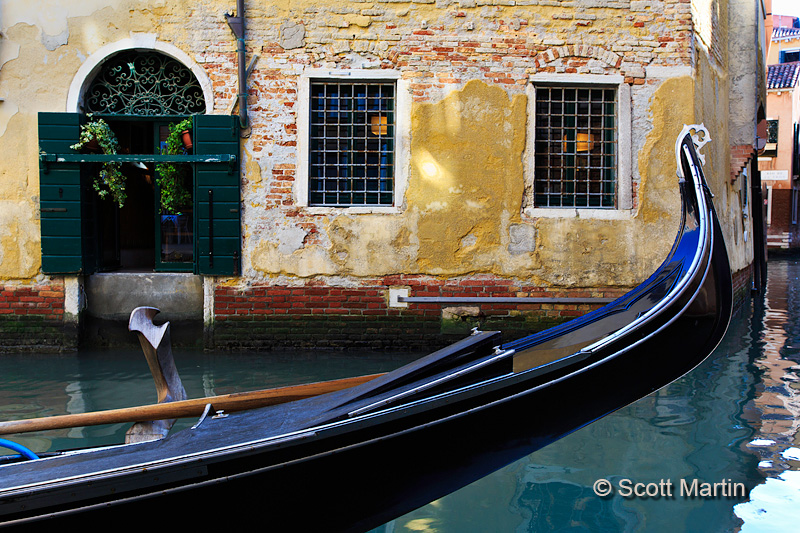
.
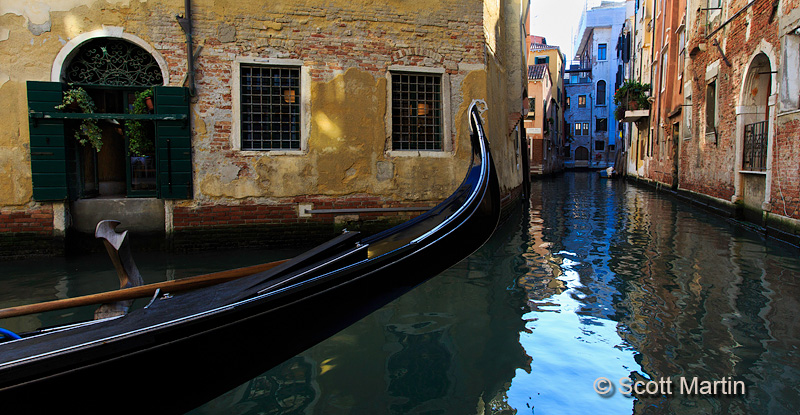
Sometimes when the sun is in the absolutely the wrong place for a photography, you can be creative and make it work in your favour. Thanks to Marco for teaching me to think ‘outside of the box’ and take a shot like this one.
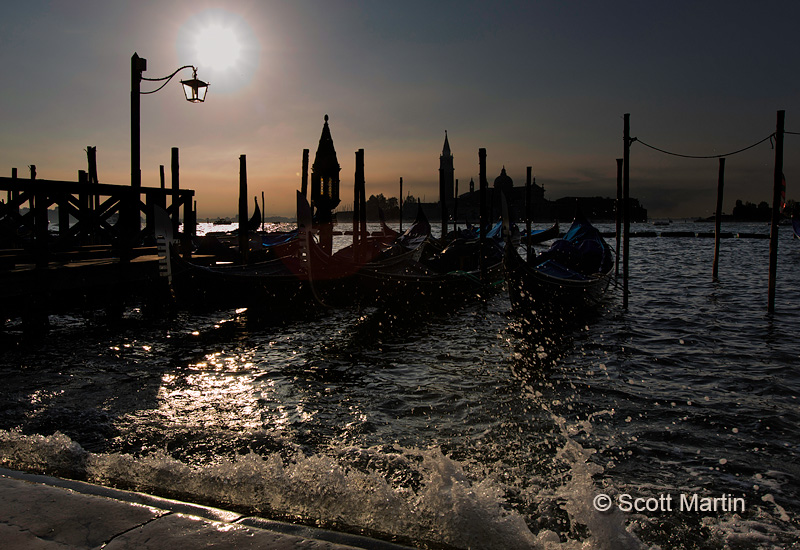
The Bridge of Sighs taken using the old white marble rails of the bridge as a frame.
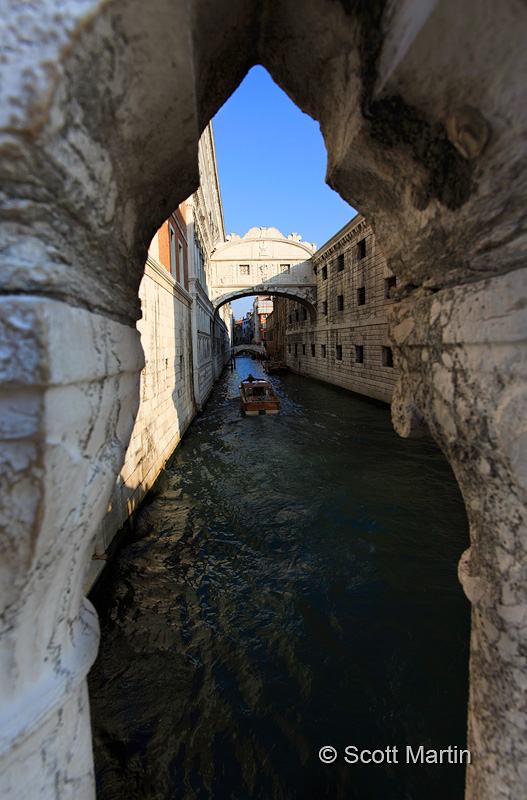
And a more traditional view.
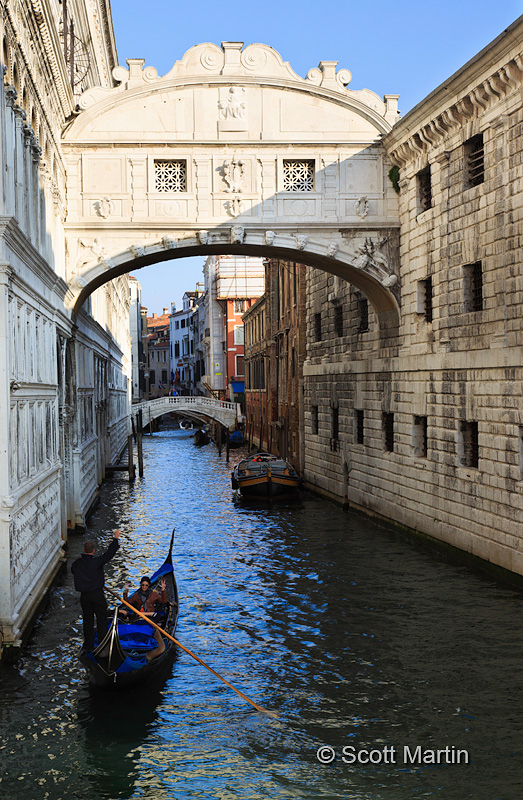
The ornate veranda columns of Doge’s Palace and the interesting shadows they cast.
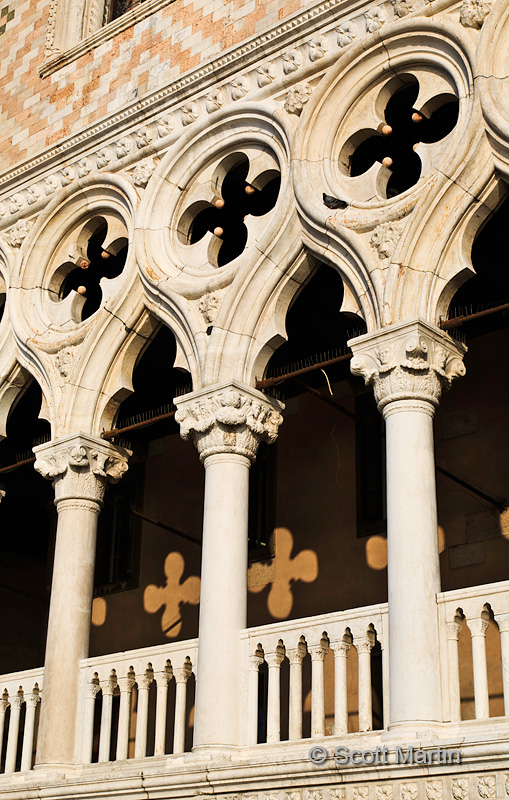
A charming Venetian Street.
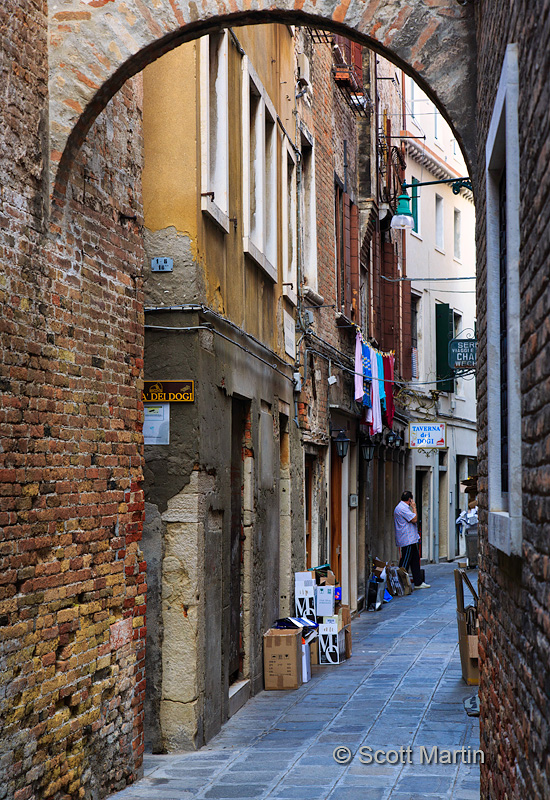
The next two shots are of the crypt below San Zaccaria, a church named after Zacharias, the father of John the Baptist. Zacharius’ body is on view in the church. The crypt below the church was flooded, however by climbing down a few old wooden stairs it was possible to get some pics. Unfortunately I did not have a tripod with me at the time so these shots are taken hand-held, ISO 4000 f/4 at 1/4 of a second.
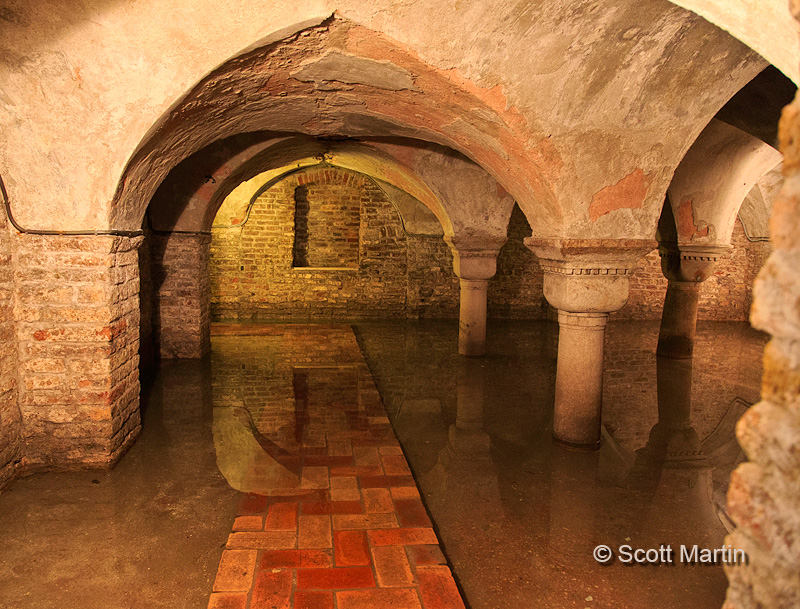
.
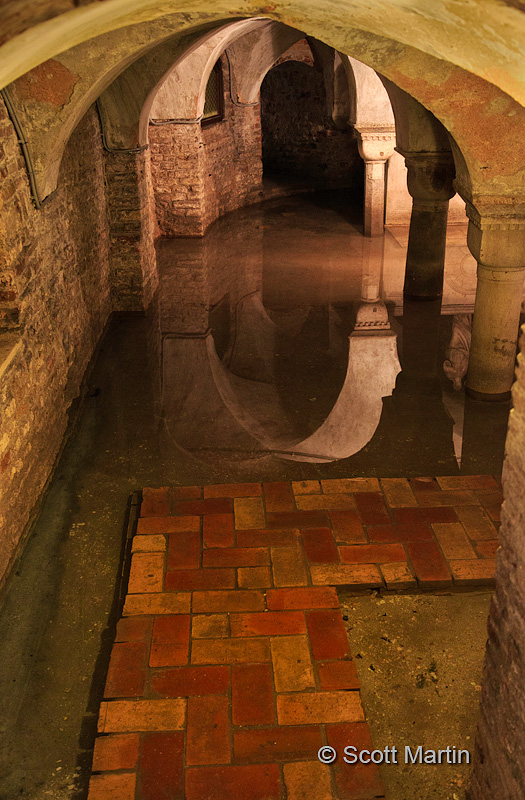
A gondolier navigating the narrow canals. No three point turns here!
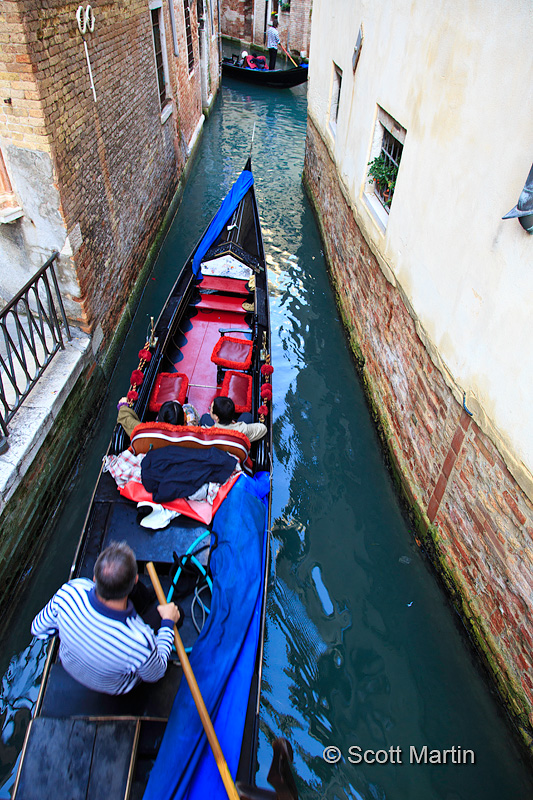
You could spend days simply photographing the windows and doors of Venice. This next image demonstrates how over the centuries nothing remains square in the city that is slowly sinking into the lagoon on which it is built.
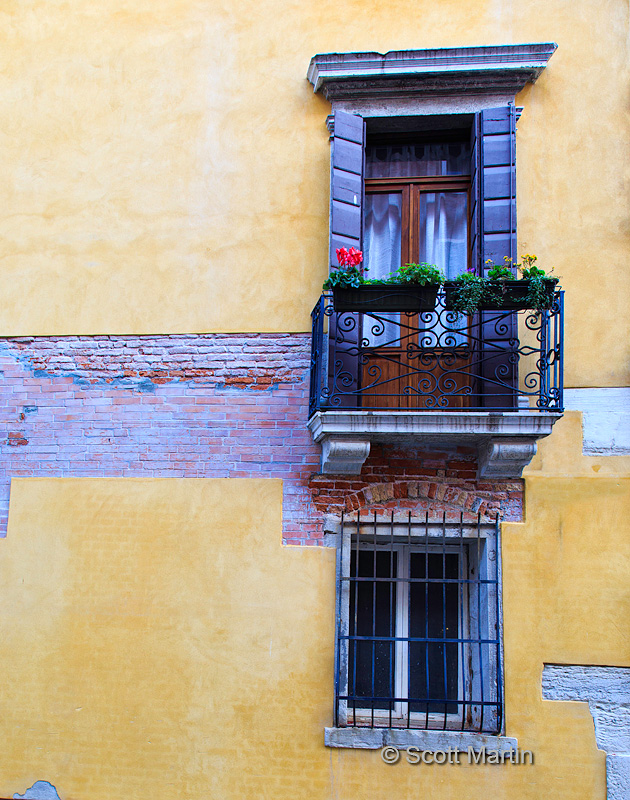
This next shot has all the quintessential components that make it easily recognizable as being from Venice.
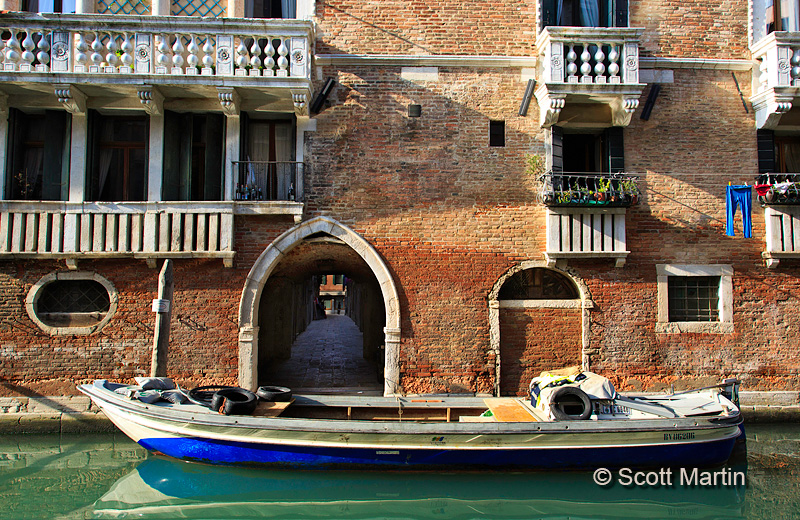
It’s great for a photographer when the colour of the clothes on the line match the boat 🙂
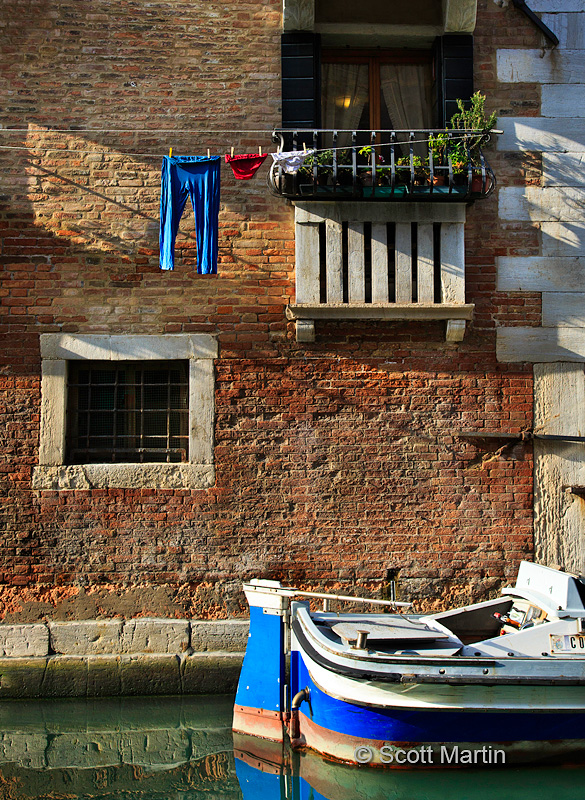
.
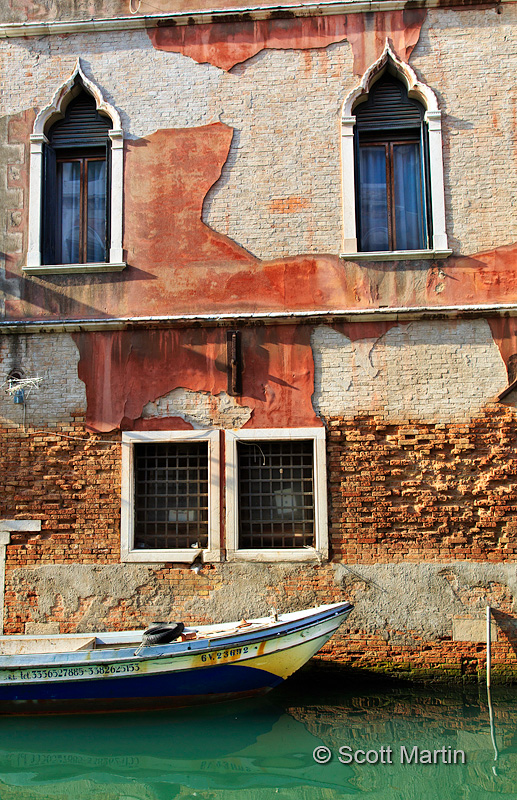
The long history and rich tradition of the gondolier is evident in the ornate detail of their gondolas.
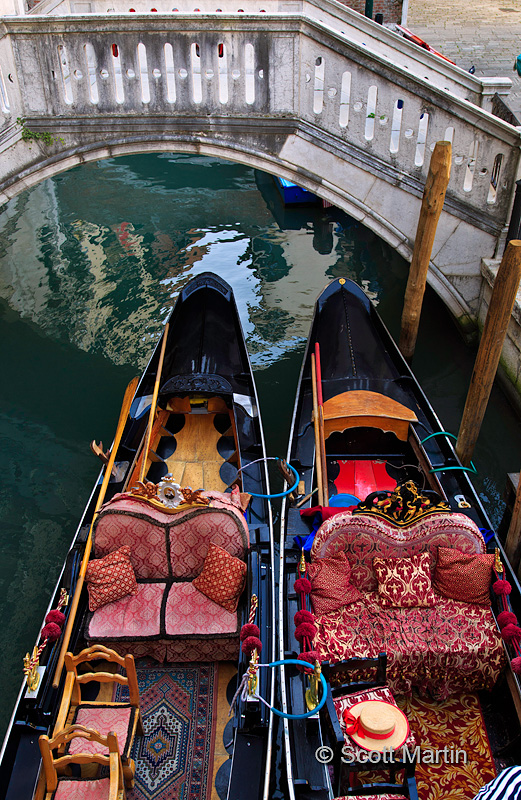
.
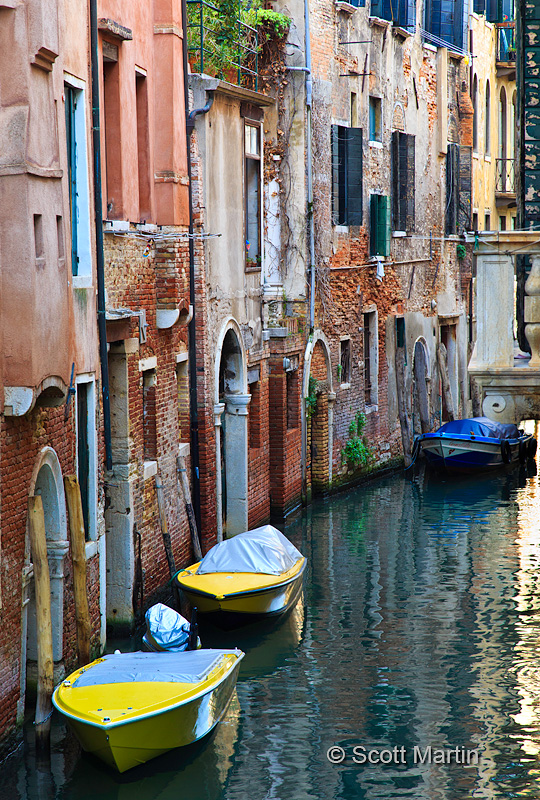
The Acqua Alta Bookshop was the most interesting and unique bookshop we have ever been in. You have to see it to believe it and we were so happy that Marco took us by for a visit.
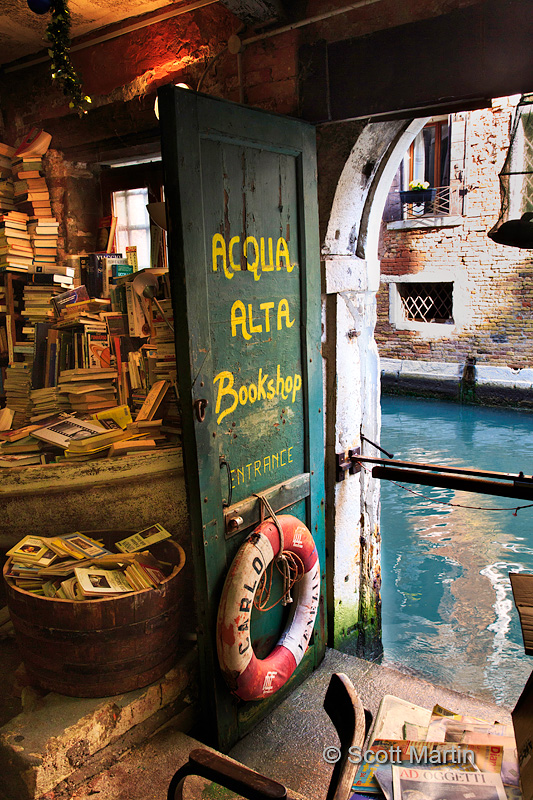
Unfortunately graffiti is a problem in Venice (as in most cities) so I’ve purposely included in this next shot of a well.
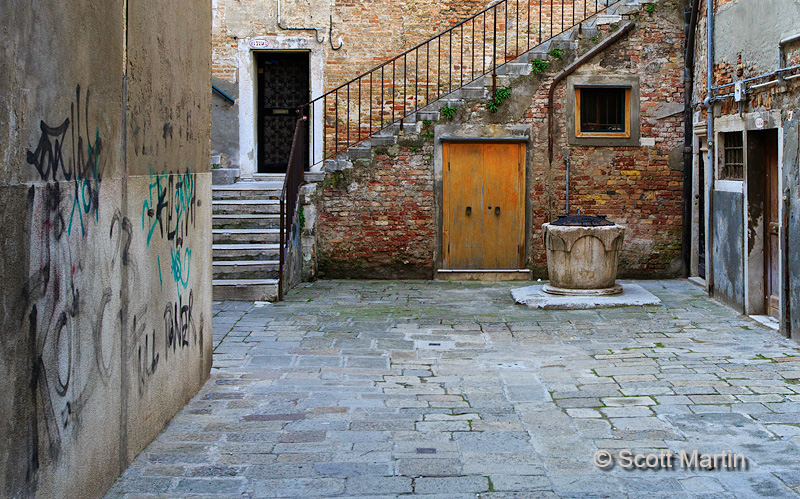
Here is an image of the same well composed to exclude the graffiti and create a completely different result.
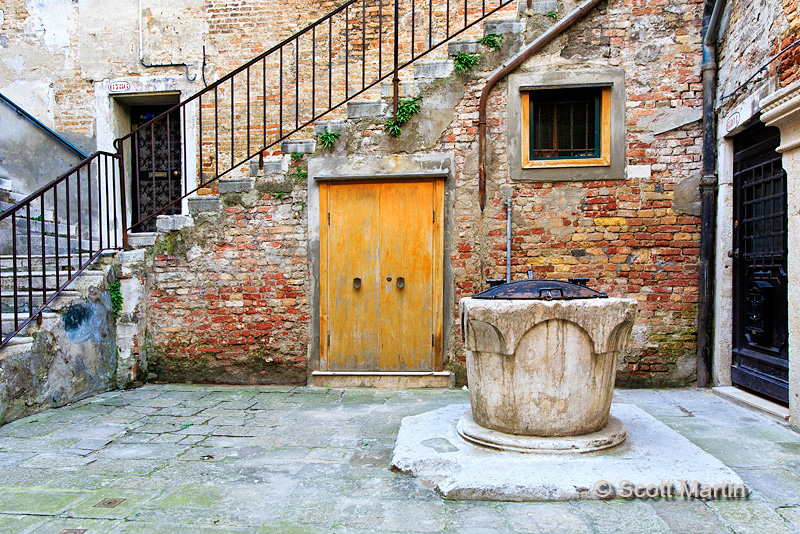
And for something totally different, a close up of red and green peppers at the market.
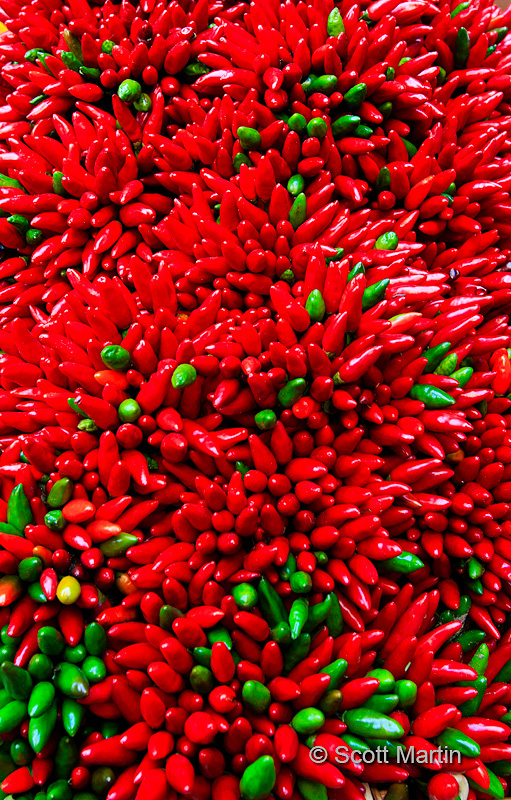
Every archway leads to a wonderful view.
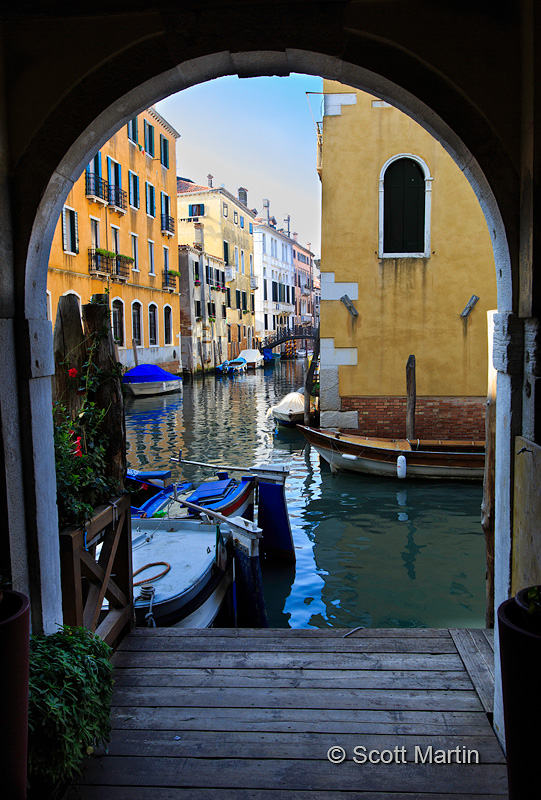
Although you’ve seen this final image before, it represents the sun going down on our time in Venice. I trust you’ve enjoyed this three part series from Venice and these photographs have either brought back fond memories of a past visit or perhaps persuaded you to add this beautiful city to your list of places to visit.
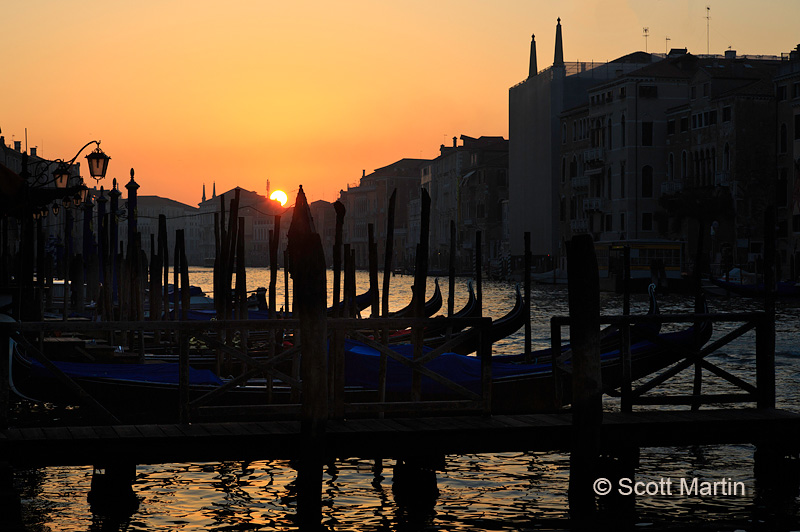
All of the images from Venice can be seen in the Venice Gallery
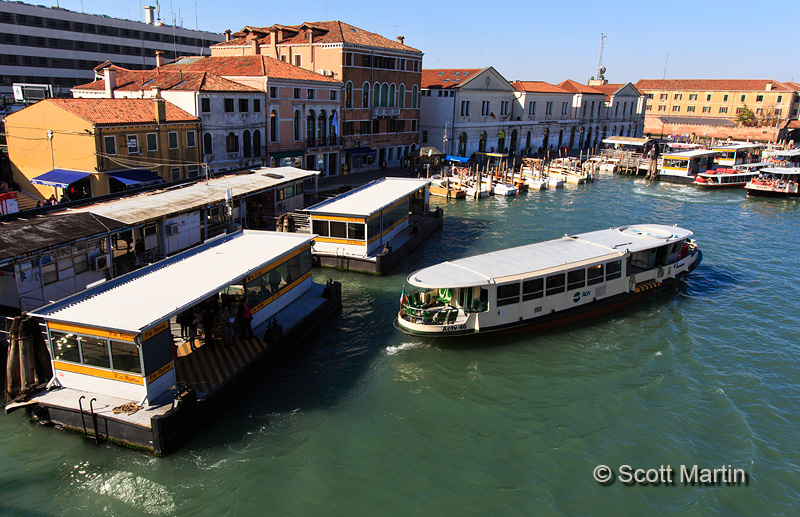
by Scott Martin Photography | Nov 9, 2013 | Blog, Cityscapes, Landscapes, Travel
Venice is an incredible city that is one of those “bucket list” places to visit. The Floating City as it is often referred to was formed around the sixth century as the Roman Empire’s power base was diminishing and attacks from the Lombards and Huns caused the people to form the defensive stronghold that became Venice, protected from easy attack by the lagoon that separated it from the mainland. The first Doge of Venice (most senior elected magistrate, elected for life) was elected around 700 AD and a continuous rule of Doge’s lasted for the next 1,000 years.
The entire city of Venice is a World Heritage Site and although in 1500 it was one of the most populous cities in the world by the end of WWII the population was 175,000 and in 2010 the population dipped below 60,000 which is less than the average number of tourists who visit the island city every day. The declining population is likely due to the very high cost of living, ironically created by the volume of tourists, causing many native Venetians to relocate to the mainland.
Arriving in Venice by car, you cross via a bridge/causeway, continue past the docks where the cruise ships rest and arrive at a multi-level parking garage where you gladly leave your car, grab your luggage, and head for the entrance of the Grand Canal where any manner of water transportation awaits. We chose the Vaporetto, which can be thought of as a water bus. This pic below shows the first Vaporetto stop at the mouth of the Grand Canal with the parking garage in the back ground.

The image above was taken from the apex of the Calatrava Bridge, which is pictured below. This bridge is one of only four that span the Grand Canal and was completed in 2008 making it the newest bridge in Venice. The Calatrava Bridge is a bit controversial in that it is a stylistically modern design, constructed of steel and glass seems esthetically disconnected from rest of the city, however it is the last ‘modern’ sight you will see until returning to your car.
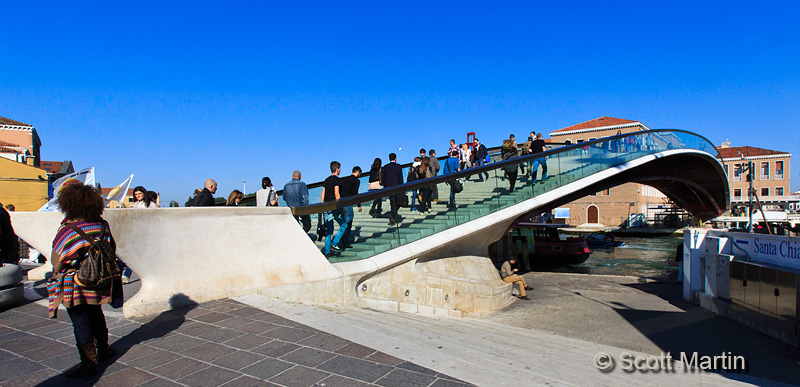
Calatrava Bridge
From the same vantage point atop the bridge but looking down the canal you get your first feel of Venice.
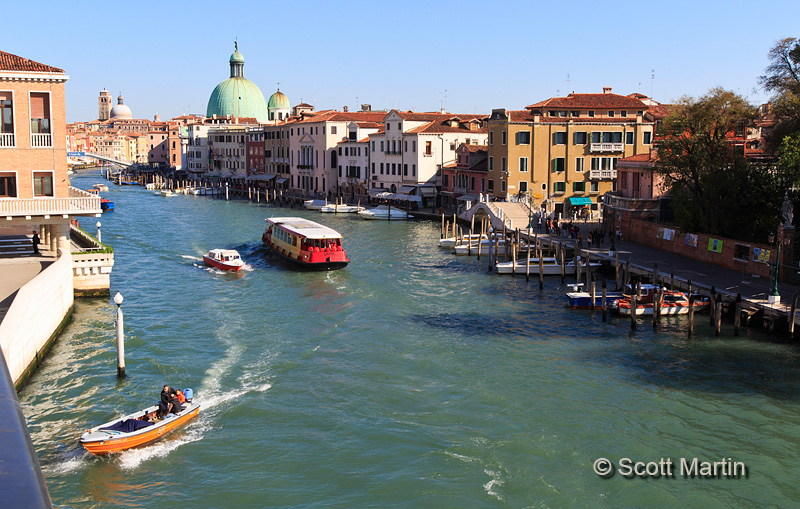
.
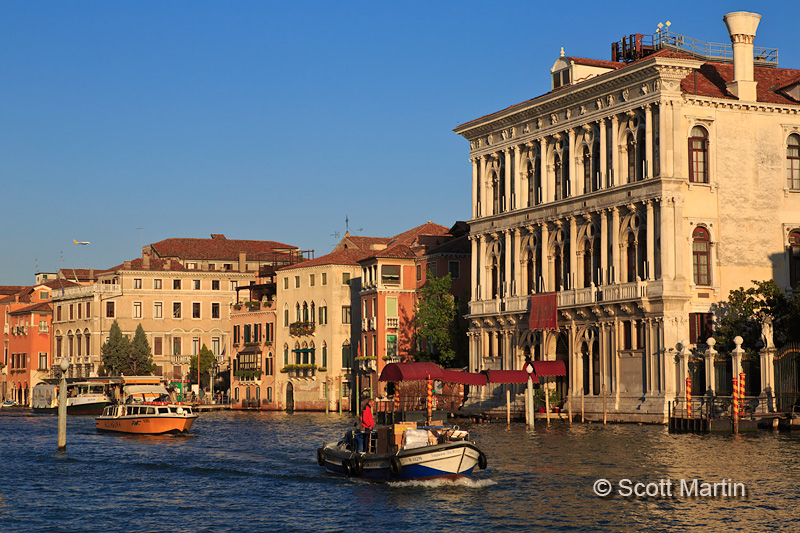
.
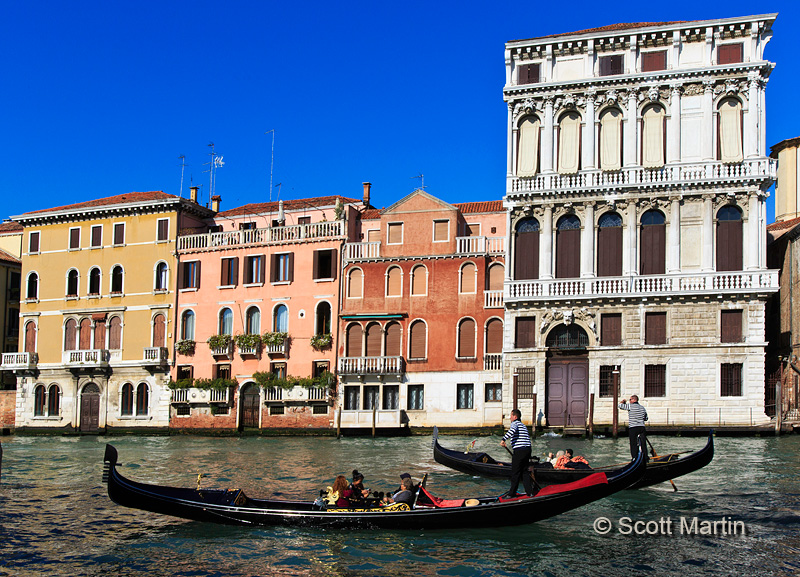
Although the Calatrava Bridge is the youngest and most controversial of the four bridges that span the Grand Canal, the Rialto Bridge is the oldest,most famous and most photographed of the quartet. The first iteration of what is now the Rialto Bridge was a pontoon bridge constructed in 1181 and replaced with a timber structure in 1255. The present stone version was completed in 1591. The Rialto Bridge and the gondolas that ply the waters beneath it are two of the most iconic fixtures of Venice. Trying to include both effectively in the same frame was a bit of a challenge but I hope we succeeded.
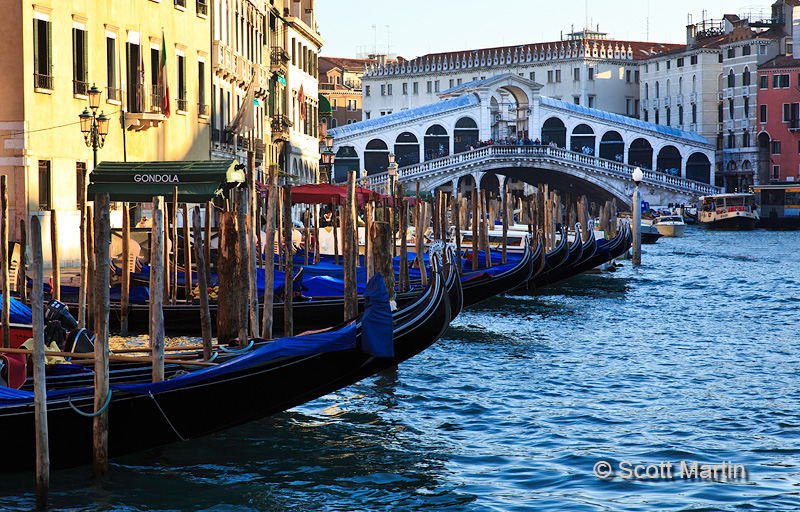
.
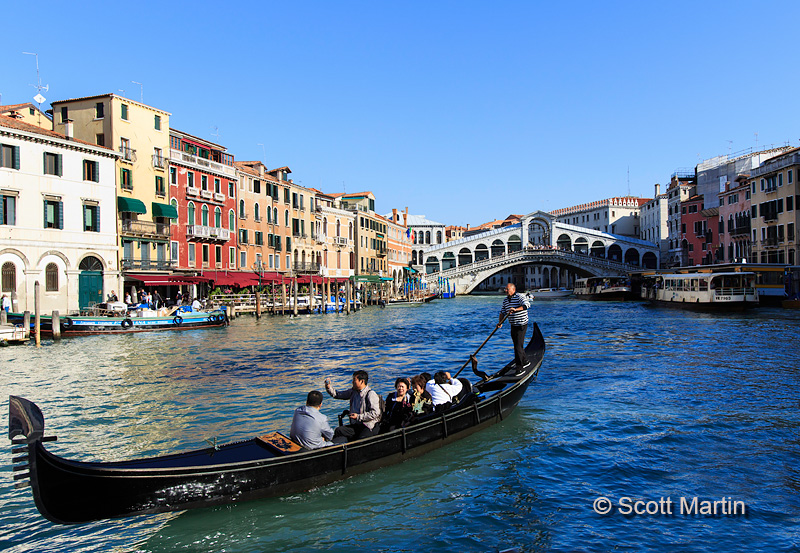
There are about 450 Gondoliers in Venice and based on tradition, you are born a gondolier in that a gondolier’s training and licence is passed from generation to generation, typically from father to son, however the first female gondolier in over 900 years was licensed in 2010. To be a gondolier in Venice makes one part of a proud and revered profession which I believe is captured in this next image.
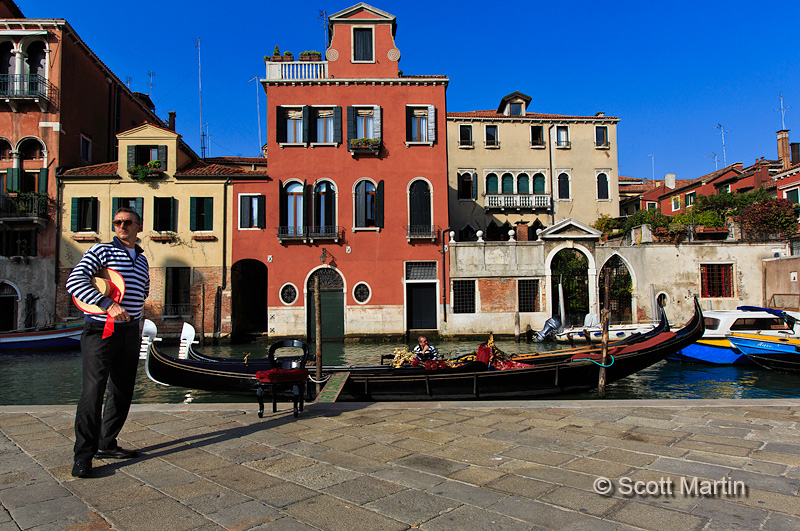
There are many quaint boutique type hotels in Venice and staying in the city adds to the charm of visiting Venice. A good example of this type of hotel is the one we stayed in, which began life as a fifteenth century palace and I would highly recommend. In fact, click here to visit their website.
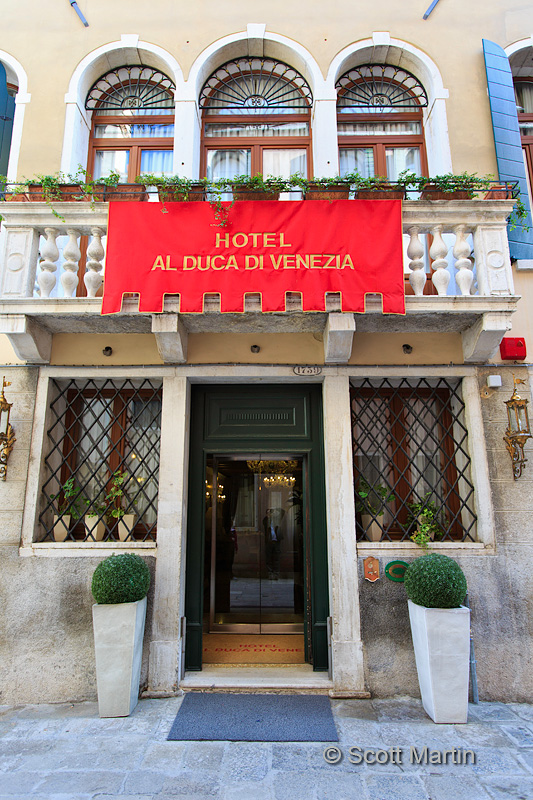
There are also hotels on a much grander scale. This angelic marble statue marks the stairway leading to the upper floor drawing room of one of Venice’s more spectacular hotels.
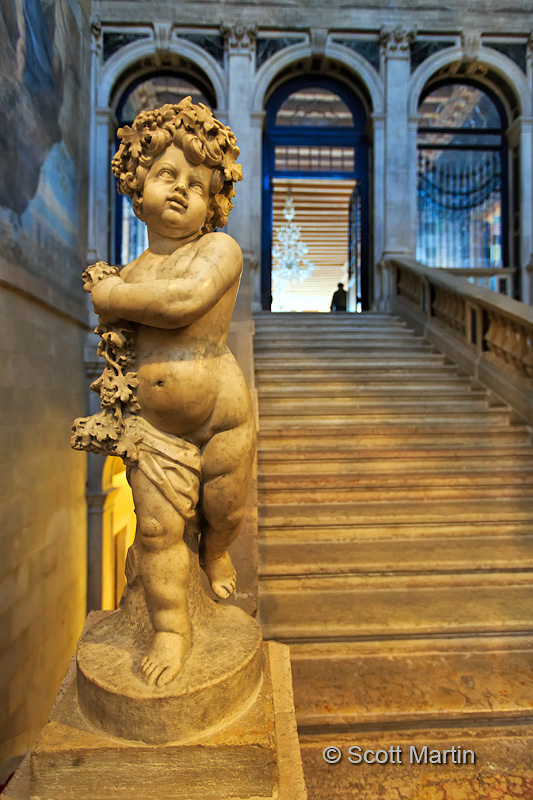
.
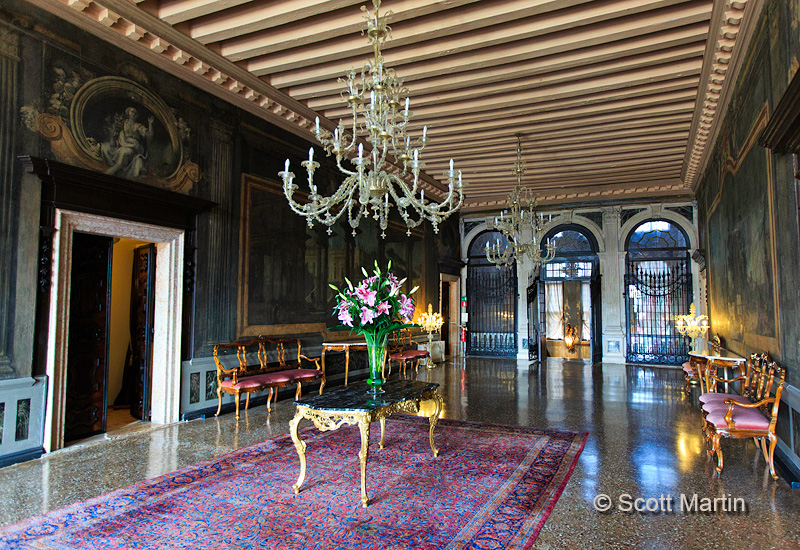
Perhaps the best known landmark of Venice is the Piazza San Marco, or as Napoleon referred to it, the drawing room of Europe. The vast expanse of the piazza can easily accomodate tens of thousands of people and it is certainly the social centre of the city.
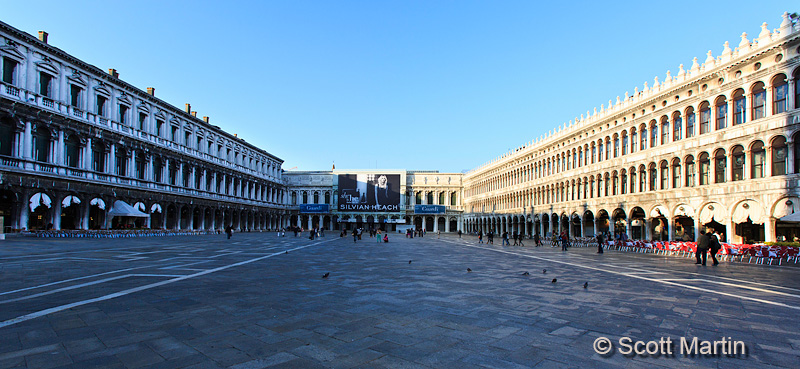
St. Mark’s Basilica dominates the east end of the Piazza San Marco while its campanile (a stand alone bell tower associated with a church) rises proudly from the piazza.
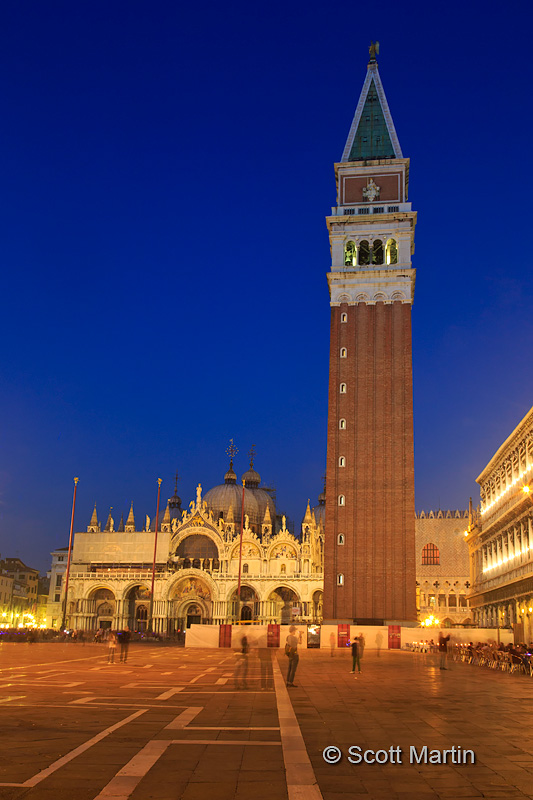
At the south east end of the piazza is another smaller area known as the Piazzetta di San Marco which runs between the Piazza and the lagoon and is bounded by the Marciana Library and Archaeological Museum on one side and Doge’s Palace on the other.
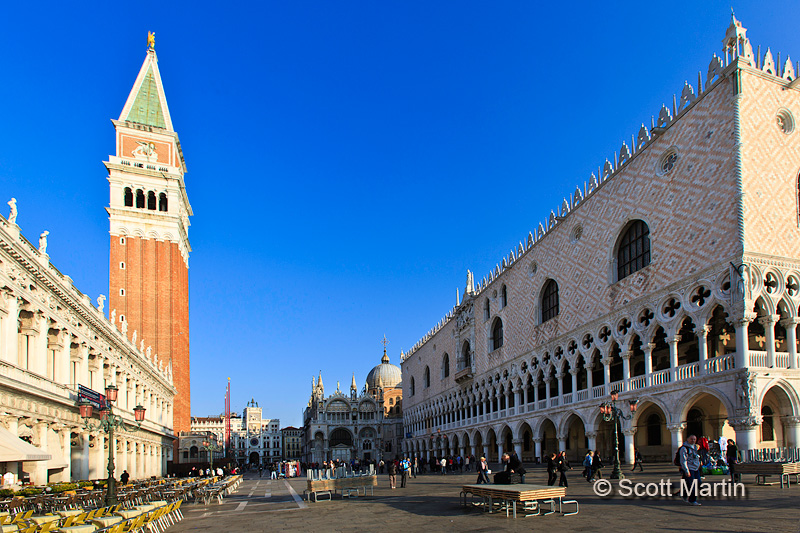
The objects that look like picnic tables in the fore ground are actually stacked portable walkways that are found throughout the public walkways of Venice. When needed they are separated and lined up end to end allowing pedestrians to stay dry and walk around the city when it is flooded which happens approximately one hundred days annually.
The Library, Archaeological Museum and Column of St. Theodore, one of the two patron saints of Venice.
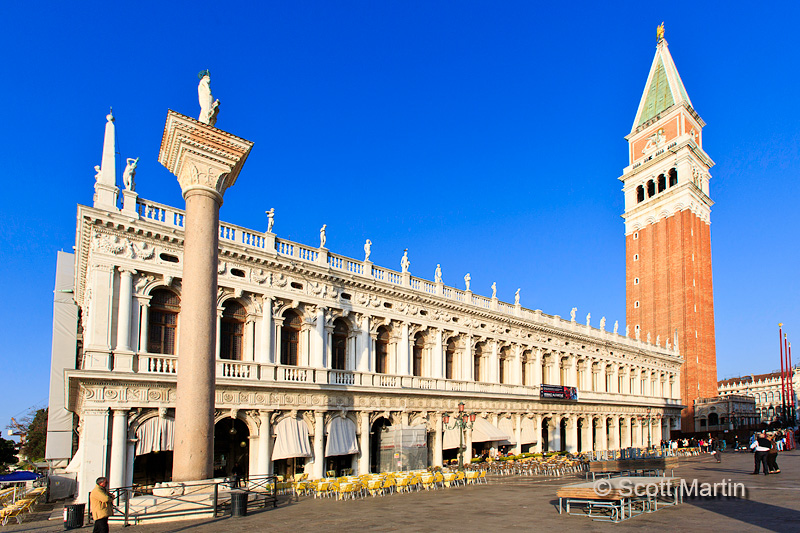
The Piazzetta taken from the lagoon with Doge’s Palace on the right side of the frame.
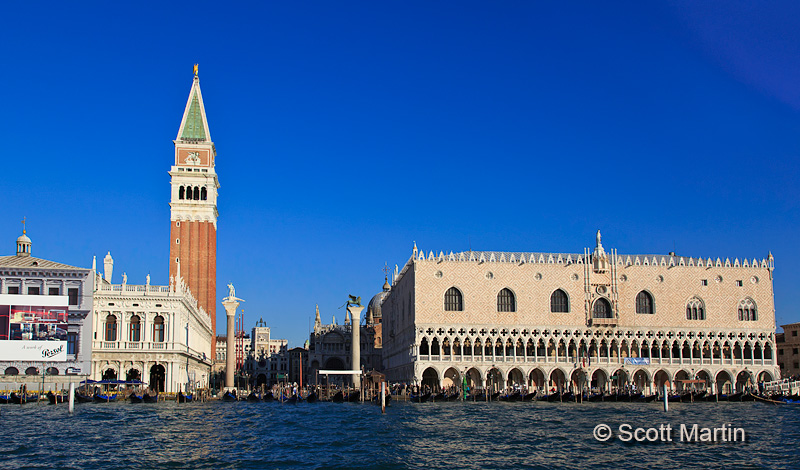
Next to Doge’s Palace, separated by a canal, is the New Prison. The famous Bridge of Sighs was built in 1614 to connect the two buildings. The bridge is completely enclosed with only small grated openings that allowed prisoners, freshly convicted by the magistrates in the palace, to catch their last view of freedom looking out through the grates to see the lagoon and the island of San Giorgio Maggiore as they were being led to the prison. The sighs they would utter gave the bridge its name.

In this next twilight image it is interesting to note the stark differences in architectural style of the palace on the left and the prison on the right.
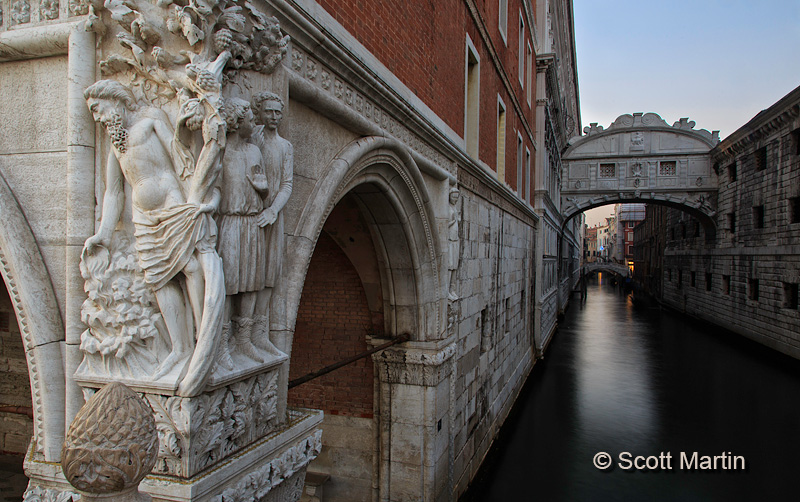
Venetians typically do not have freezers in their homes and rely on fresh food daily which is probably a good idea that we should all emulate. Markets are found throughout Venice and greatly add to the charm of the city.
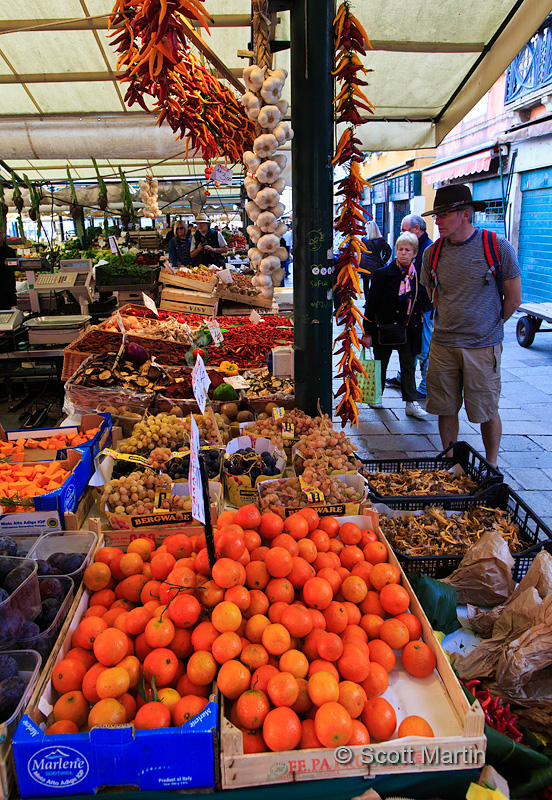
I trust you have enjoyed this more travelogue type view of Venice and that it has given you a good sense of feel for this wonderful city. The next blog post will be a more artistic photographic tour of Venice.
To close this post, we head over to the island of San Giorgio Maggiore and to the top of the bell tower of the Church of San Giorgio Maggiore which provides the perfect vantage point for a view of Venice. While at the top of the bell tower my 24-105mm lens suffered a catastrophic failure and and this was the last time I used the lens on our vacation. I’m sure the photographers reading this will feel a little sorry about my misfortune 🙂

.
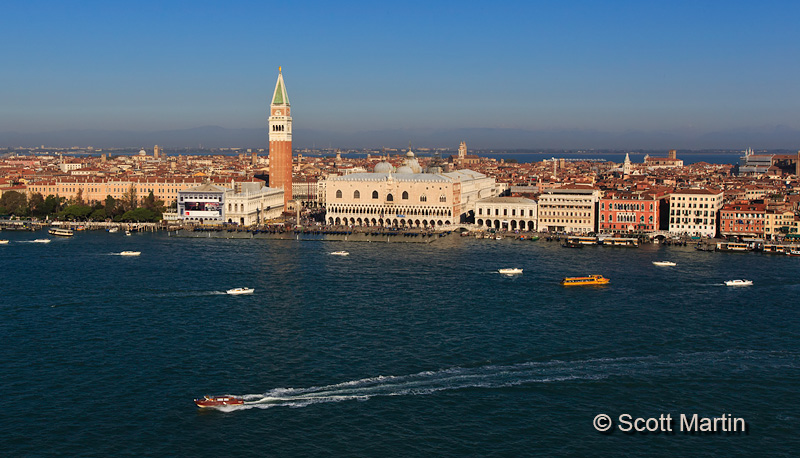

by Scott Martin Photography | Oct 29, 2013 | Blog, Cityscapes, Landscapes, Travel
On our last day in Rome, we headed to the train station and found the Avis Car Rental location where our Citroen Picasso, with its diesel engine and six speed manual transmission was waiting for us. Over the next two weeks we would travel over 4,000 km in our little rental, which included a few harrowing escapades, not the least of which was exiting from the very first roundabout we entered (about 200m from the car rental agency) by going the wrong way on a one way street which necessitated reversing back into the roundabout which was not well received by the many cars flying through the circular intersection. It was a fitting introduction to driving in Europe! Anyway we eventually made it to the Autostrade and quite enjoyed the 530 km drive from Rome, north-east to Venice.
Venice is an absolutely spectacular city located in the North East region of Italy on the edge of the Adriatic Sea. The city itself is built on a collection of 118 closely knit islands in the Venice Lagoon that are separated by a complex series of canals yet connected by many small pedestrian bridges. There are no vehicles in Venice other than the boats in many forms that ply the waters of the canals and it doesn’t take long to appreciate the charm of a city without cars!
One of the best decisions we made in the planning of our trip was to spend our first half day in Venice with Marco Secchi, a professional photographer born in Venice who now shares his time between homes in Venice and London. We met Marco early at the Rialto bridge and spent the entire morning walking through the city, learning about its rich history and taking in the sights of the city from the perspective of a native Venetian. Marco also taught me much about capturing the essence of Venice with a camera and how to ‘see’ the good shots that presented themselves to us, which was a new thing for a bird photographer! If you are planning to visit Venice, you simply must do so when Marco is available to show you around, even if you are not a serious photographer, he will even show you how to use your iPhone camera! Check out Marco’s website, his photography is superb and you can also book him for your own tour of Venice! Tell Marco that Deb & Scott sent you 🙂
Like Rome, I have too many images to include in a single blog post, so this will be the first instalment of two or perhaps three posts. It was difficult to know how to categorize the images to best present them, however I thought I would start with some photographs showing Venice at night.
For those with a keen eye, you will notice that this first shot was not taken at night but rather in mid morning with the sun still high in the sky. It is included not because it looks a little like a nightscape but because it is a perfect example of an image Marco taught me how to take. In fact, while I was sitting down on the ground to frame the image properly Marco was calling out when the next wave was about to crash on the shore line to help us create the best possible photographic result. Never would I have ‘seen’ to take this picture looking directly into the bright sun, yet Marco’s instruction resulted in one of my favourite pictures of Venice.

Sunset on the Grand Canal.

The lesser light of the sky above San Giorgio Maggiore.
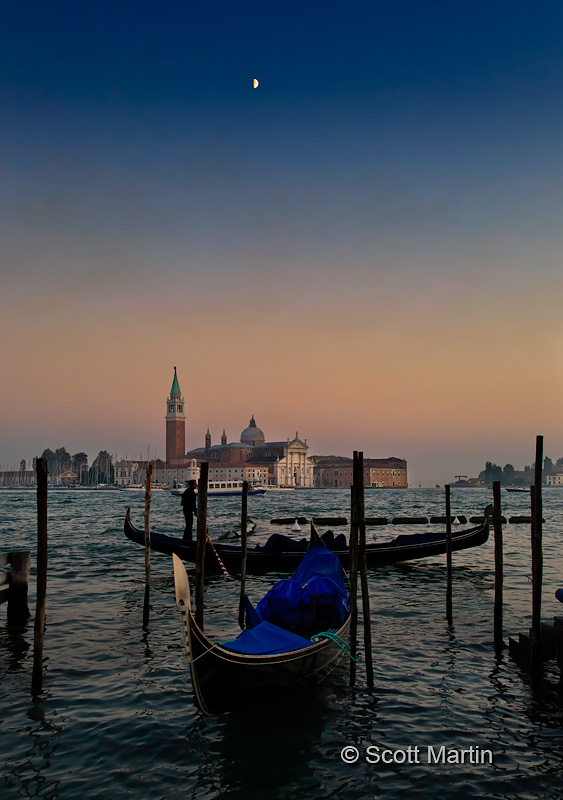
Looking along the shoreline adjacent to Piazza San Marco (St. Mark’s Square).
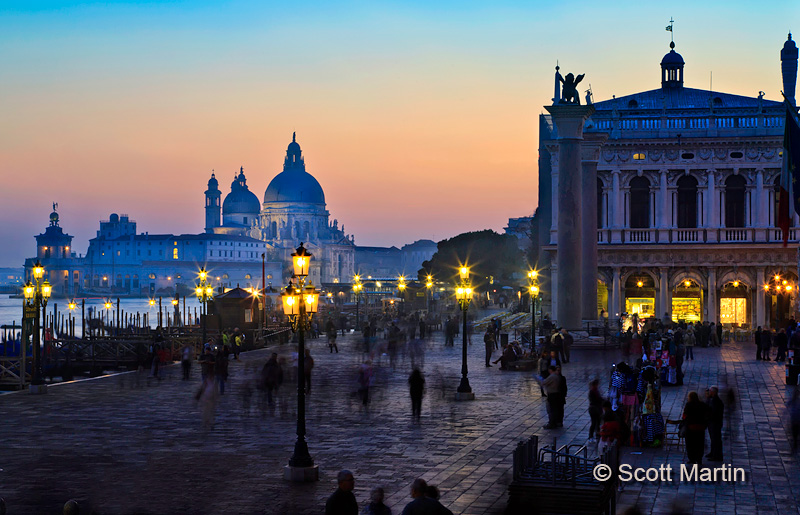
This next image was taken very close to where the previous one was taken but now looking into the Piazzeta leading into Piazza San Marco and the side of the Basilica di San Marco (St. Mark’s Basilica).
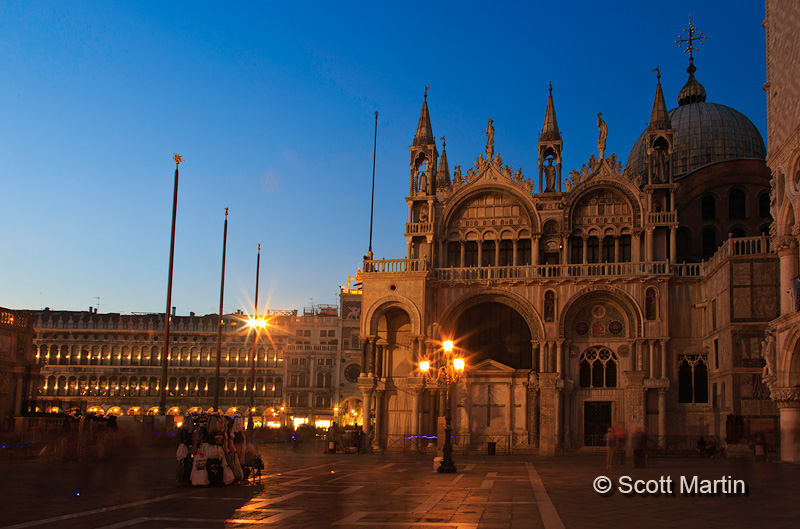
The Campanile of St. Mark’s Basilica was first built in 1156 and then rebuilt in 1912. It is free-standing in the Piazza.

These next four images are of the Bridge of Sighs, one of Venice’s many famous landmarks. They were all taken after sunset and required shutter speeds ranging from 8 to 15 seconds yet don’t immediately appear to be night shots. I can promise you it was much darker when these pics were taken than it appears in the photographs. They are included here to encourage you to always have a tripod with you experiment with tight photography. Often the deeper shadows and cool light make for interesting results. The first two images are entirely natural light while the last two have the bridge flood lit. Notice the green colour cast on the first of these pics taken before the flood lights had heated up to their normal operating temperature.
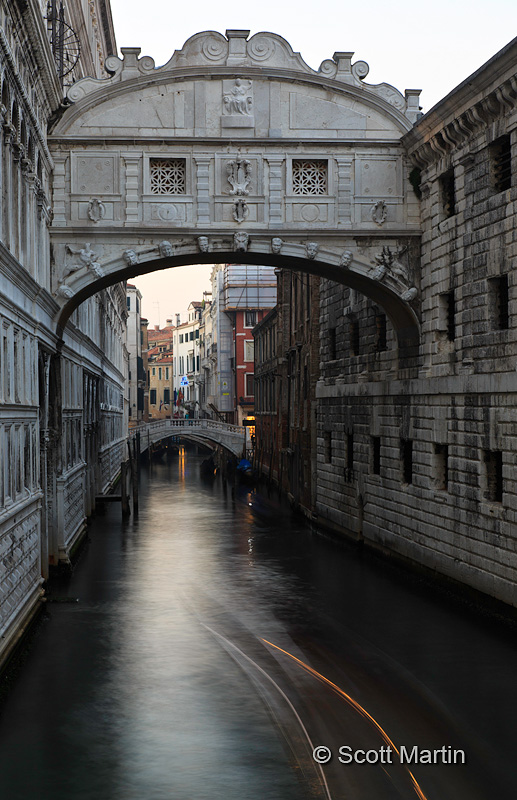
ISO 100; f/22; 8 sec; 65mm

ISO 100; f/22; 10 sec; 24mm
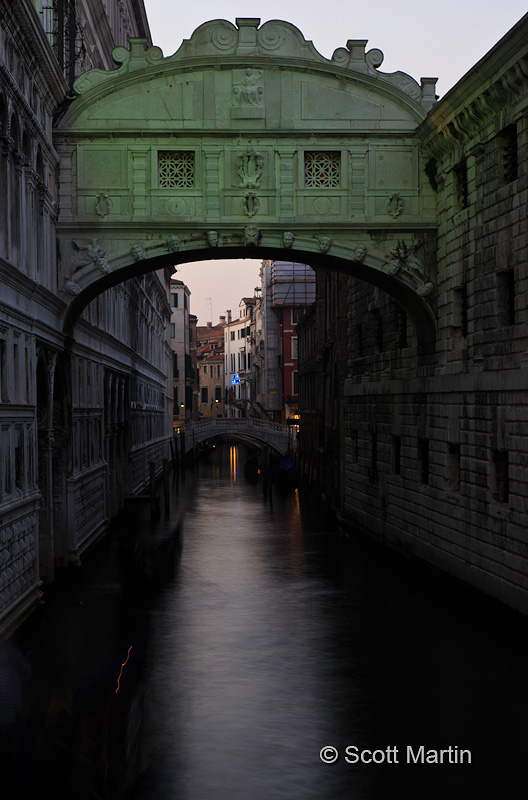
ISO 100; f/22; 8 sec; 65mm and green cast from the flood lights while warming up.
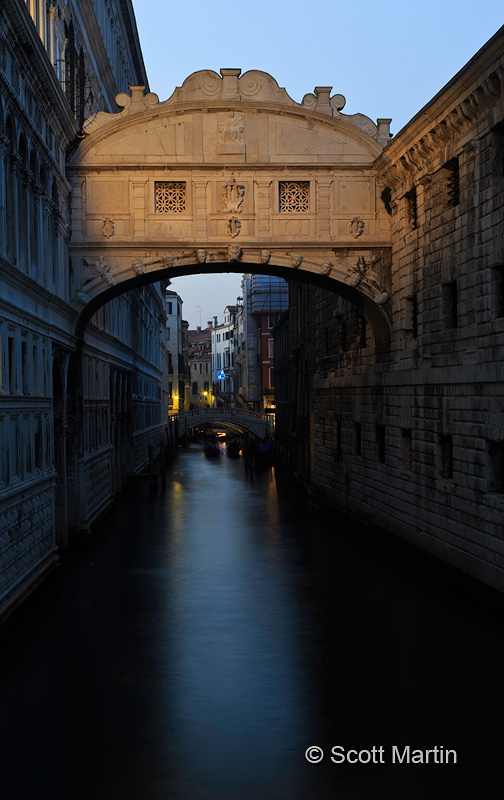
ISO 100; f/22; 15 sec; 55mm and floodlights now providing ‘natural’ colour.
As a general rule you want to take night shots while the sky still has some natural light ands therefore retains some blue colour. This is important as the sky will continue to ‘frame’ the buildings and objects within the composition and create the necessary silhouette. Once the sky is completely black, the objects in the fore ground run into the black back ground and lose their definition which is typically detrimental to the effectiveness of the image. All of the previous images were taken while there was still some light in the sky and thus all the objects within the images are well defined. The images that follow are all taken after the sky has become completely black, however when in Venice you just can’t put your camera away so you break the rules and steady your tripod!
A small piazza a couple of blocks from our hotel where we were enjoying a late dinner sitting outside on the restaurant patio. Beautiful!
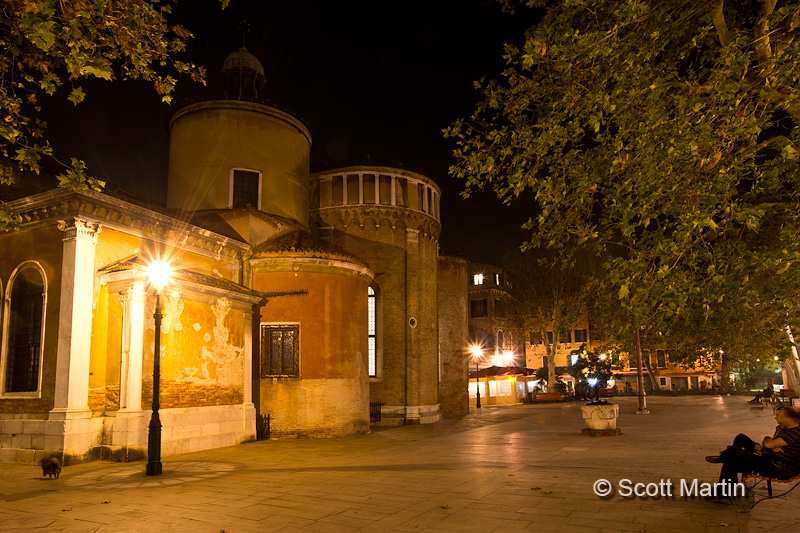
The Casino di Venezia.
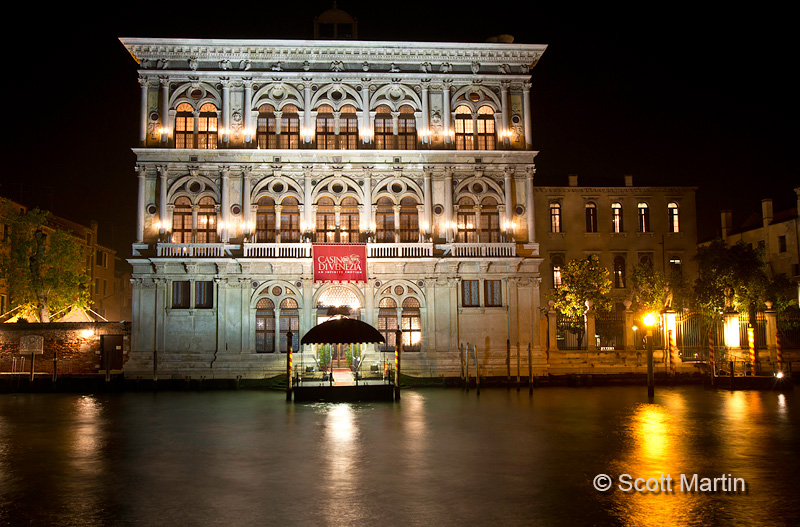
The Rialto Bridge is probably the most famous and photographed bridge in Venice. Here it is from behind.
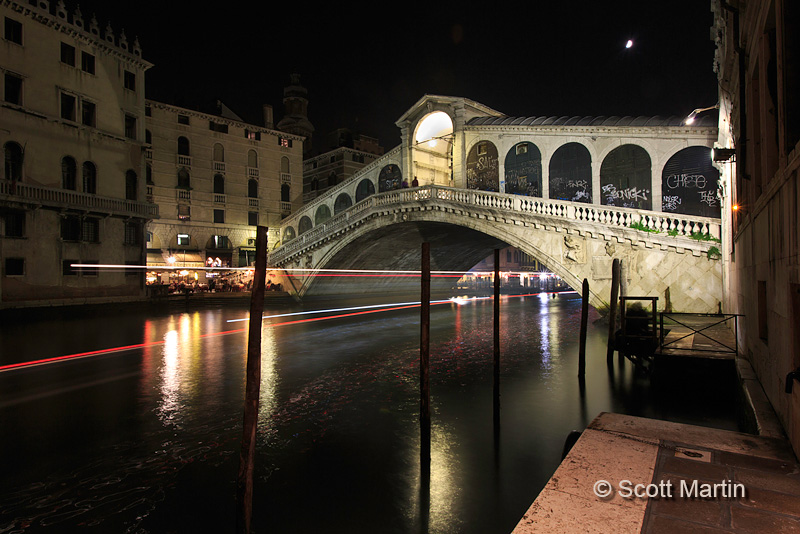
And from the front.
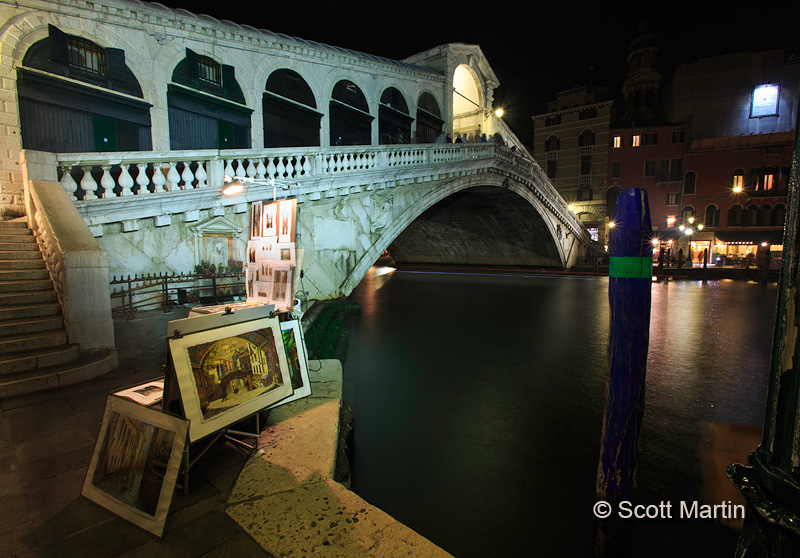
.
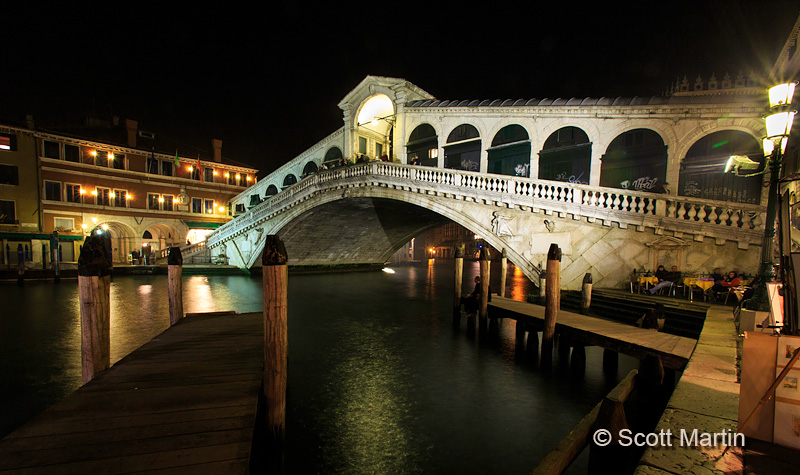
.
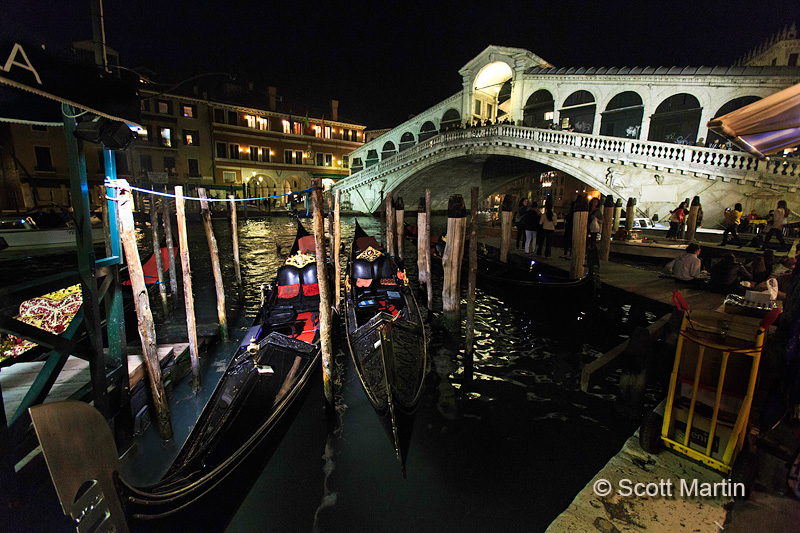
And finally a view looking down the Grand Canal from the apex of the Rialto Bridge.
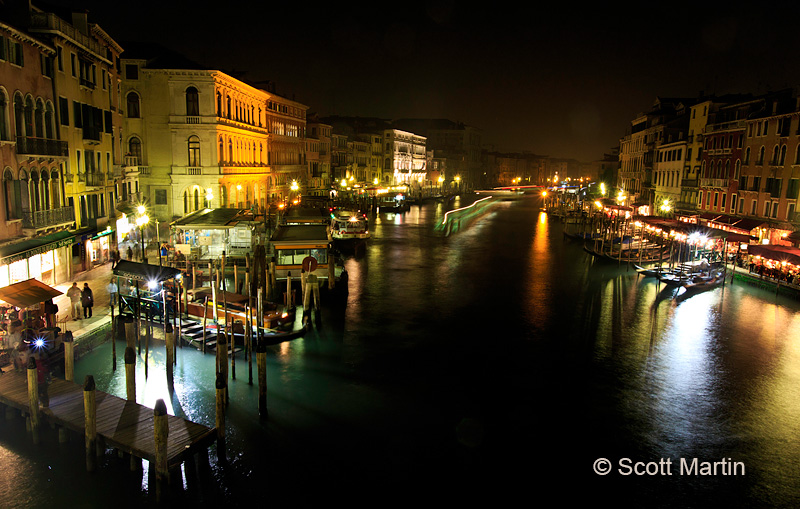
I trust you enjoyed these night shots from Venice and if you haven’t already done so dust off your tripod and try your hand at photos after dark. You will be pleasantly surprised by the results!
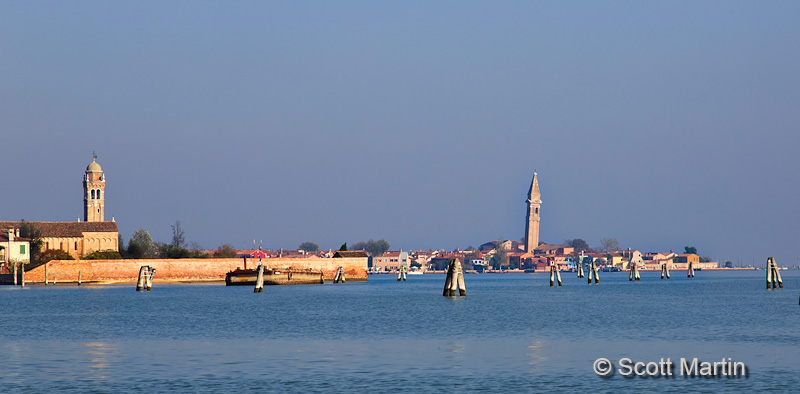
by Scott Martin Photography | Oct 8, 2013 | Blog, Cityscapes, Educational, Landscapes, Travel
The conclusion of my last post stated that the next blog entry would be from Venice, however in sorting through the pics from Venice it became obvious that the number of interesting images will require multiple blog entries. So while I’m working the Venice posts, here are a few shots from the tiny island of Burano….close to Venice but a charm all its own.
Burano is a 52 acre island that was first settled by the Romans in the sixth century. It is about 7 km from Venice and you arrive on the island via a 45 minute Vaporetto ride. The population of Burano is about 2,800. The main export of Burano is lace and although that is mostly for the tourist trade, historically the island is known for the best quality of lace in the world. Leonardo Di Vinci visited the island in 1481 purchasing a lace that was used for the altar in a European church and soon all the churches around the globe wanted Burano lace.
As you approach the island, long before you arrive you notice the leaning campanile of the Church of San Martino which dominates Buranos’s skyline.

For a photographer, although lace and leaning towers are interesting, what Burano is really known for is its colourfully painted houses and reflective canals which in the late afternoon light provides photo opportunities like non other.
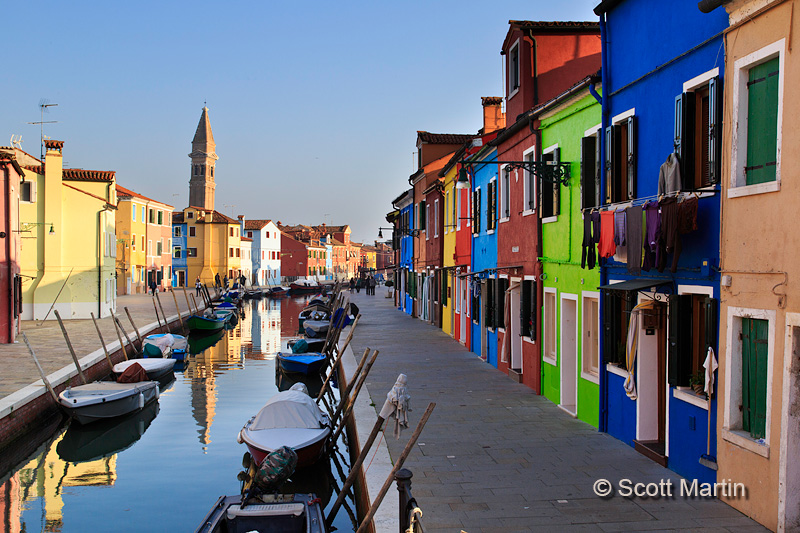
.
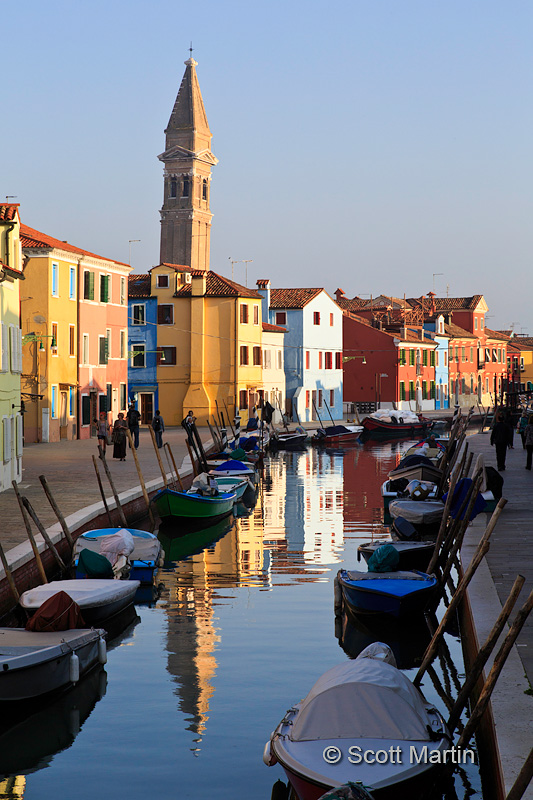
.
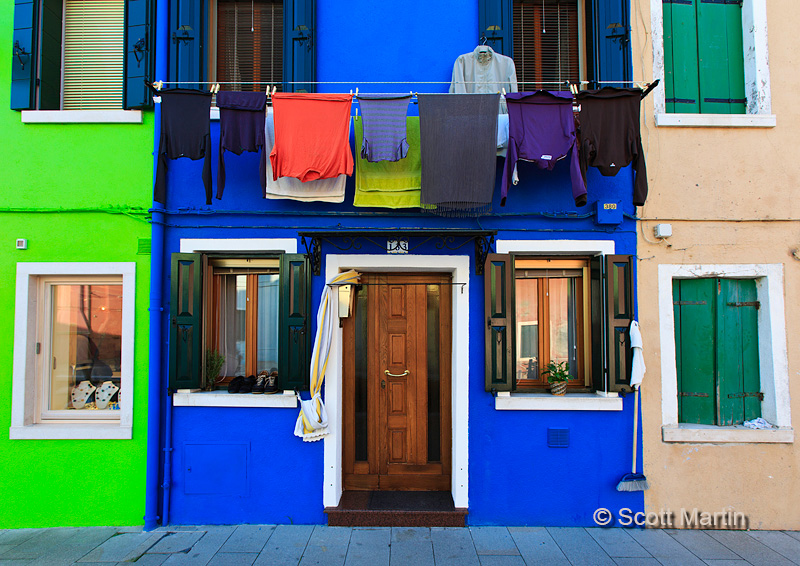
.
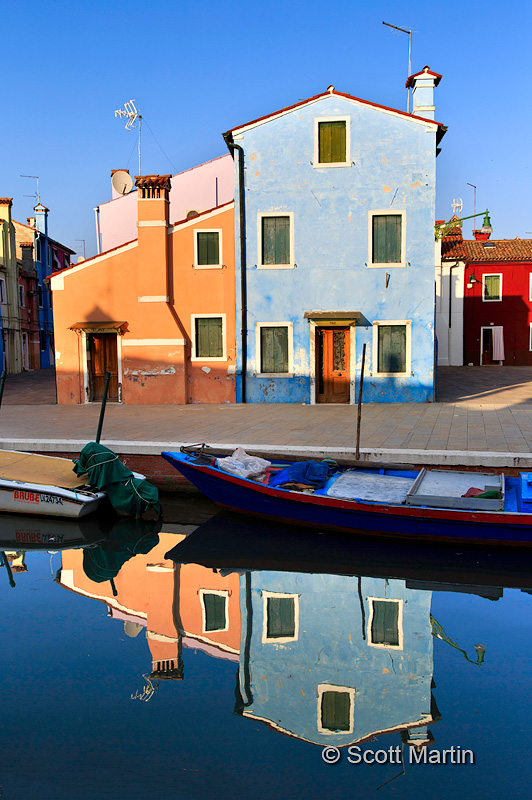
.
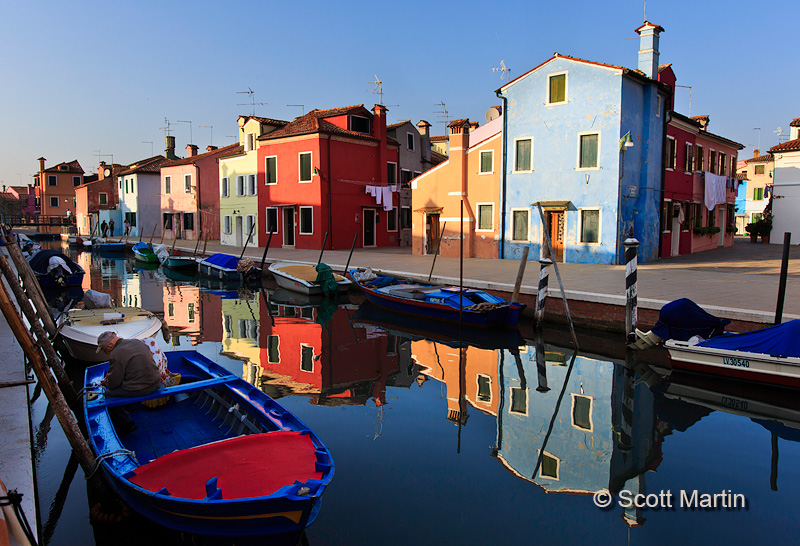
.
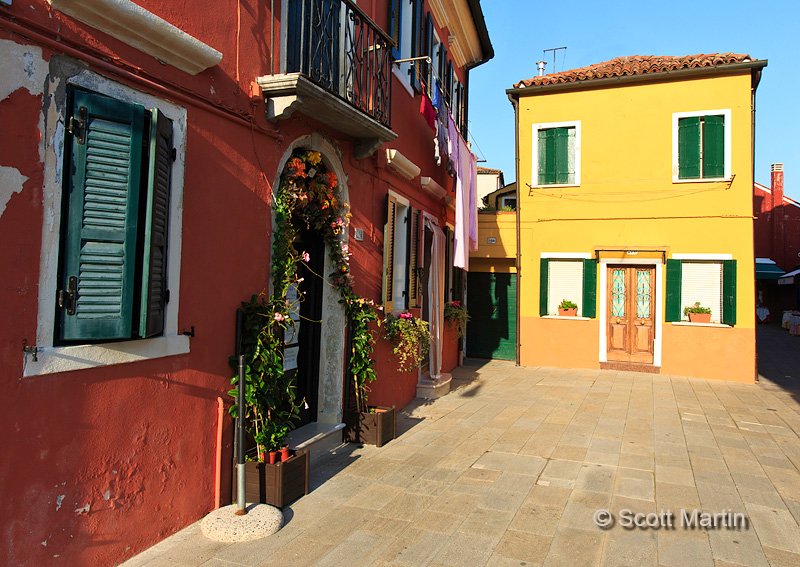
.
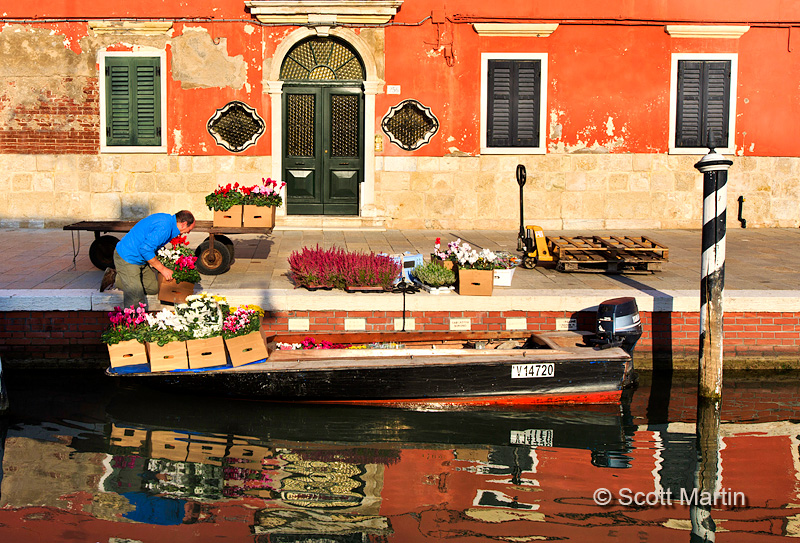
.
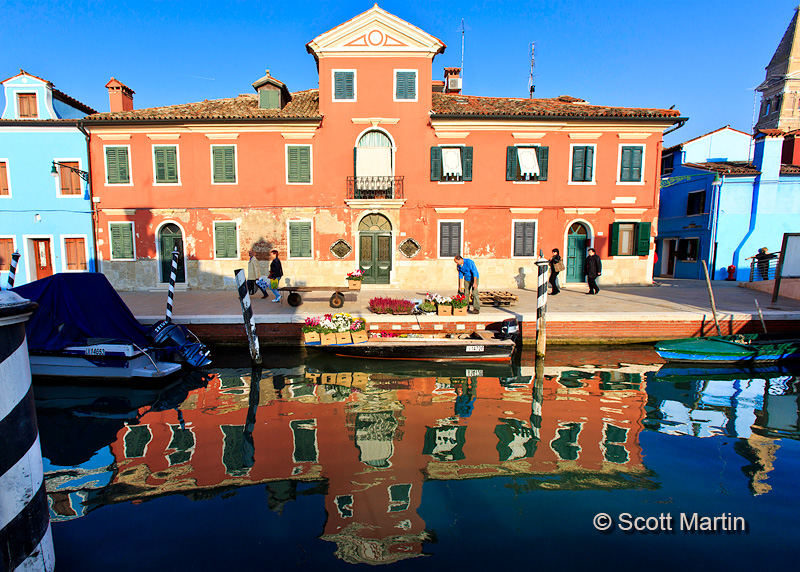
.
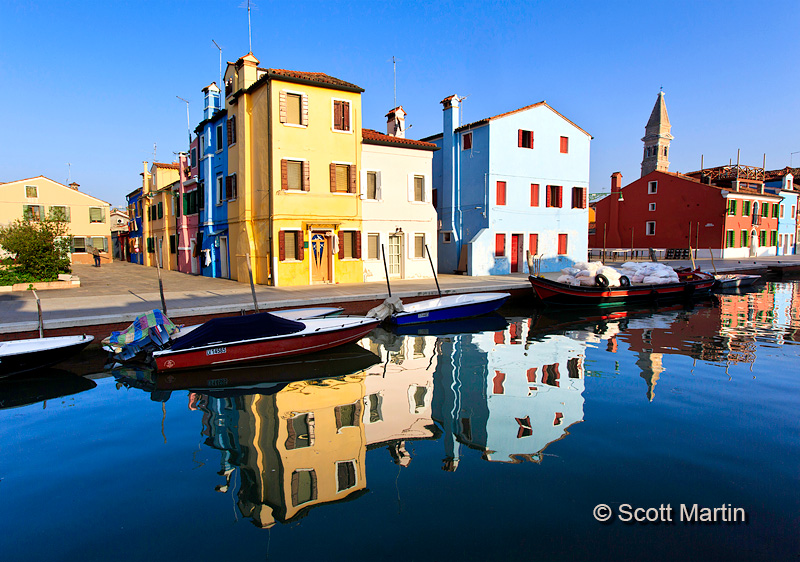
.
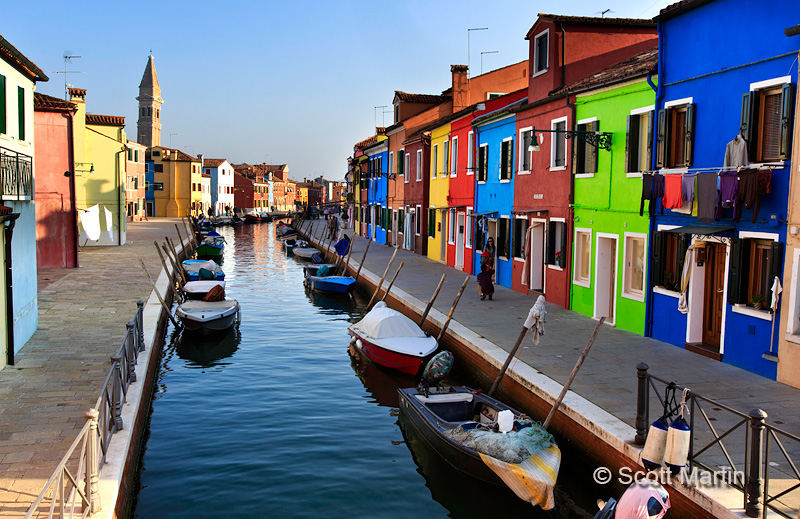
.
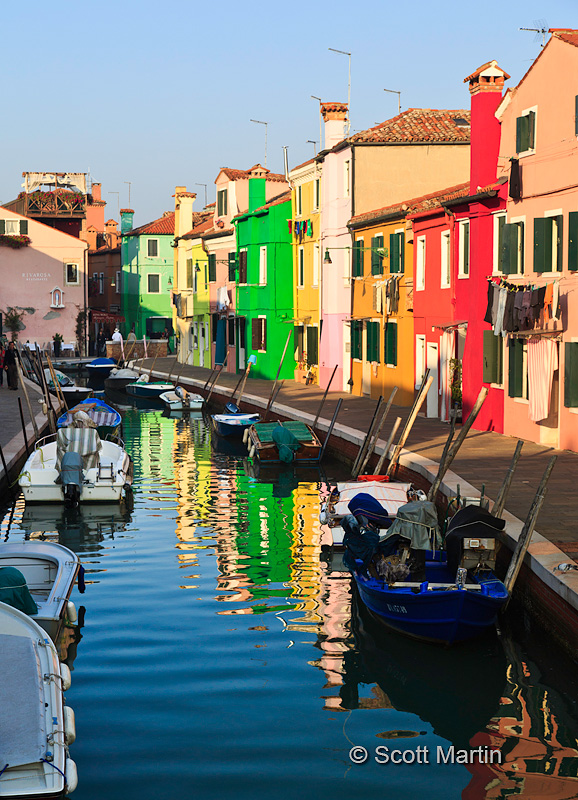
.
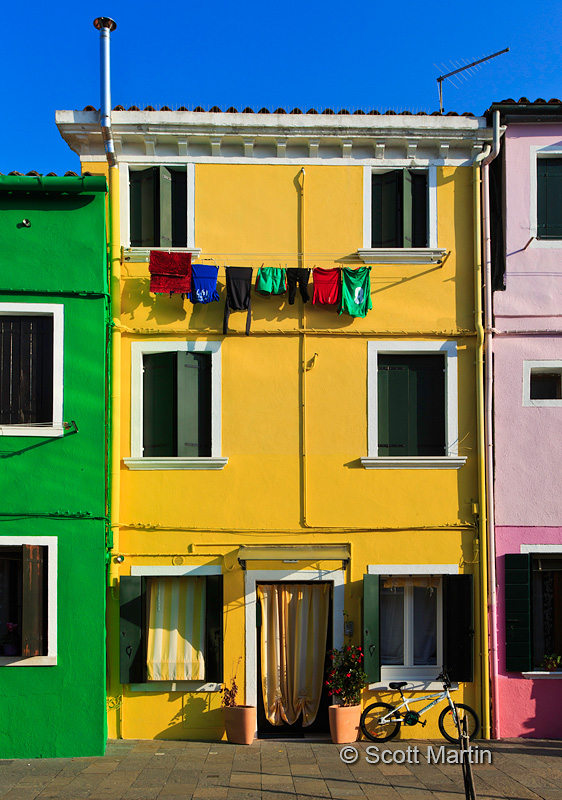
The colourful houses of Burano also provided countless windows and doorways that in and of themselves were fascinating objects to photograph. I trust you enjoy this sampling.
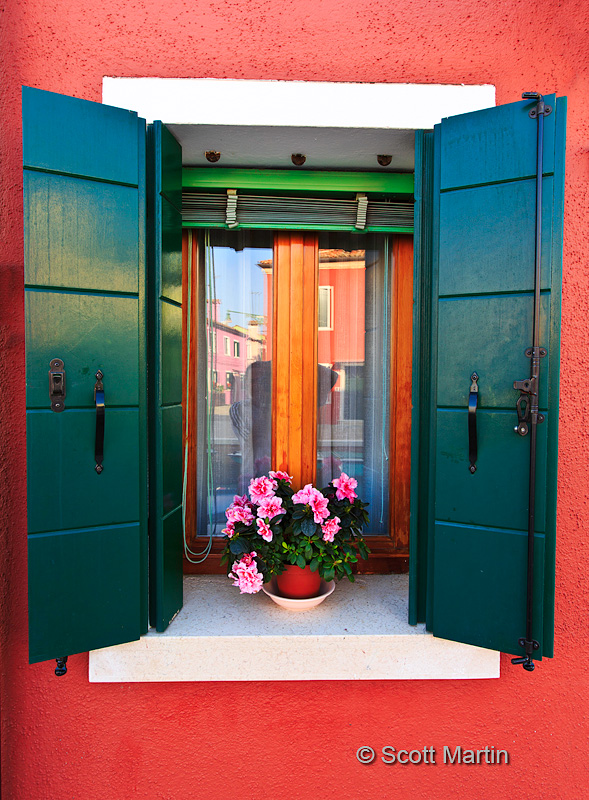
.
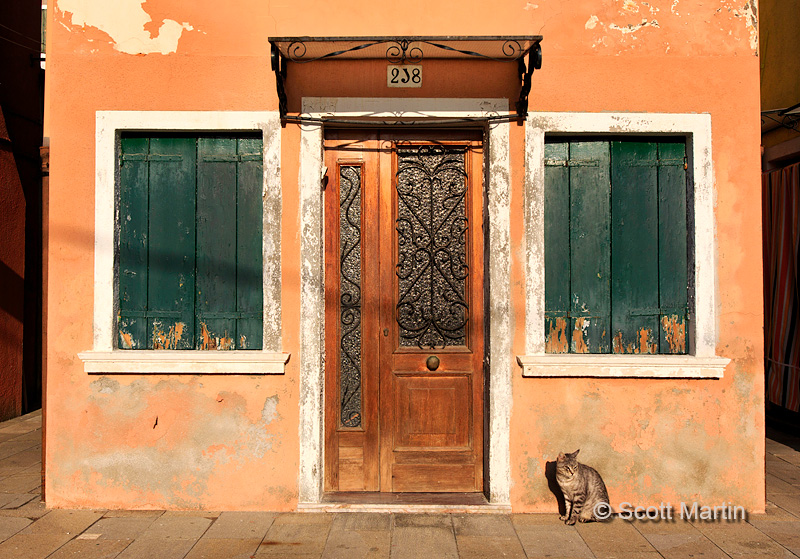
.
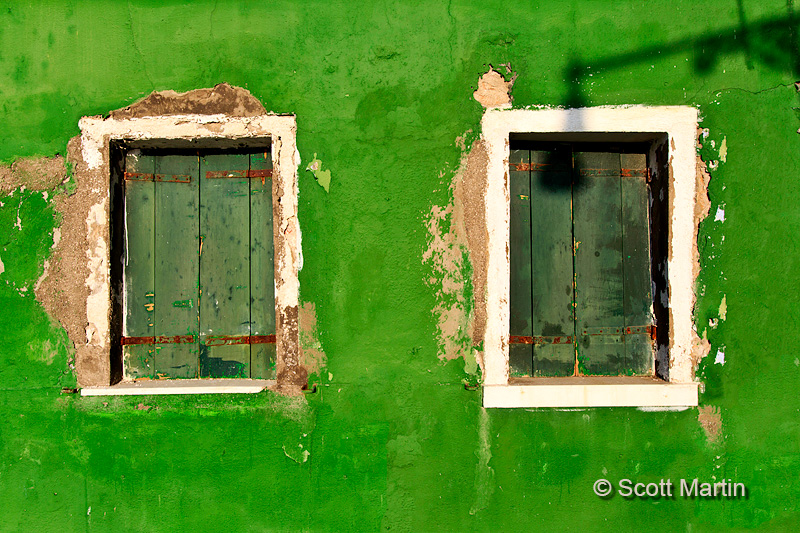
.
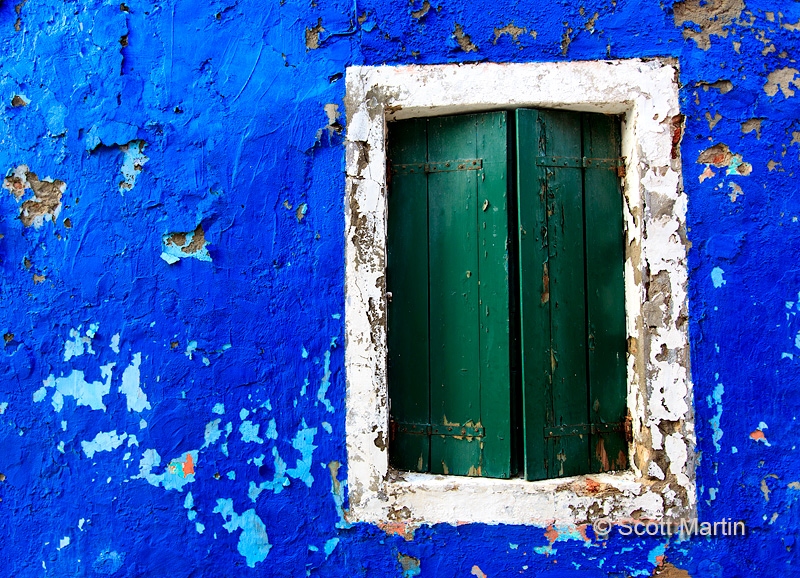
This last image is probably my favourite; not sure why but I guess that’s the subjective nature of photography!
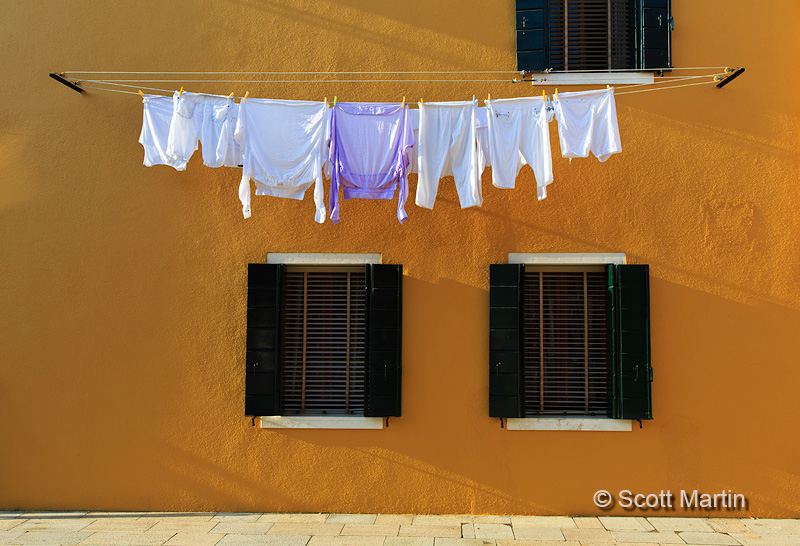
You can also view these images in the Burano Gallery
….and now back to sorting through Venice pics!























































































































Follow Scott Martin Photography